inbox and environment news: Issue 551
August 21 - 27, 2022: Issue 551
Masked Lapwing Plover Chicks Were In Danger: Now They're Dead
Local councils responsibilities as defined under the Local Government Act 1993 directs councils to properly manage, develop, protect, restore, enhance and conserve the local environment for which it’s responsible, in a manner that’s consistent with and promotes the principles of Ecologically Sustainable Development.
That's why it was so surprising to see the local council recommending formalising illegal bike tracks at Ingleside and North Narrabeen, where wildlife was once safe and could live in peace, and where at least one wallaby has already been run over by a biker. Visit: Council's Open Space and Outdoor Recreation and Action Plan Open For Feedback: Supports Formalising Illegal Bike Tracks In Bush Reserves and Public Parks feedback closed August 14.
Under the Local Government Act 1993 :
36E Core objectives for management of community land categorised as a natural area
The core objectives for management of community land categorised as a natural area are—
(a) to conserve biodiversity and maintain ecosystem function in respect of the land, or the feature or habitat in respect of which the land is categorised as a natural area, and
(b) to maintain the land, or that feature or habitat, in its natural state and setting, and
(c) to provide for the restoration and regeneration of the land, and
(d) to provide for community use of and access to the land in such a manner as will minimise and mitigate any disturbance caused by human intrusion, and
(e) to assist in and facilitate the implementation of any provisions restricting the use and management of the land that are set out in a recovery plan or threat abatement plan prepared under the Threatened Species Conservation Act 1995 or the Fisheries Management Act 1994.
36J Core objectives for management of community land categorised as bushland
The core objectives for management of community land categorised as bushland are—
(a) to ensure the ongoing ecological viability of the land by protecting the ecological biodiversity and habitat values of the land, the flora and fauna (including invertebrates, fungi and micro-organisms) of the land and other ecological values of the land, and
(b) to protect the aesthetic, heritage, recreational, educational and scientific values of the land, and
(c) to promote the management of the land in a manner that protects and enhances the values and quality of the land and facilitates public enjoyment of the land, and to implement measures directed to minimising or mitigating any disturbance caused by human intrusion, and
(d) to restore degraded bushland, and
(e) to protect existing landforms such as natural drainage lines, watercourses and foreshores, and
(f) to retain bushland in parcels of a size and configuration that will enable the existing plant and animal communities to survive in the long term, and
(g) to protect bushland as a natural stabiliser of the soil surface.
Councils also have a range of functions, powers and responsibilities that can influence NRM on public and private land. This includes strategic planning and development control, managing public land, and regulating private activities. Natural Resource Management (NRM) activities include biosecurity, stormwater, biodiversity, roadside environmental management, water quality, as well as restoration and rehabilitation of habitat and support to local bush care and land care activities. They do not as yet specify any required response to wildlife in peril in these LGA's.
However, no council in Sydney states it is or will be responsible for the wildlife living within these LGAs. No legislation compels them to do so.
All councils refer you on to wildlife organisations that exist solely because of volunteers who also pick up all the costs for saving local wildlife, as well as donating hundreds of hours each month to look after animals that come into care.
Council's Bushland and Biodiversity Policy Statement, published February 2021, outlines their own current commitments.
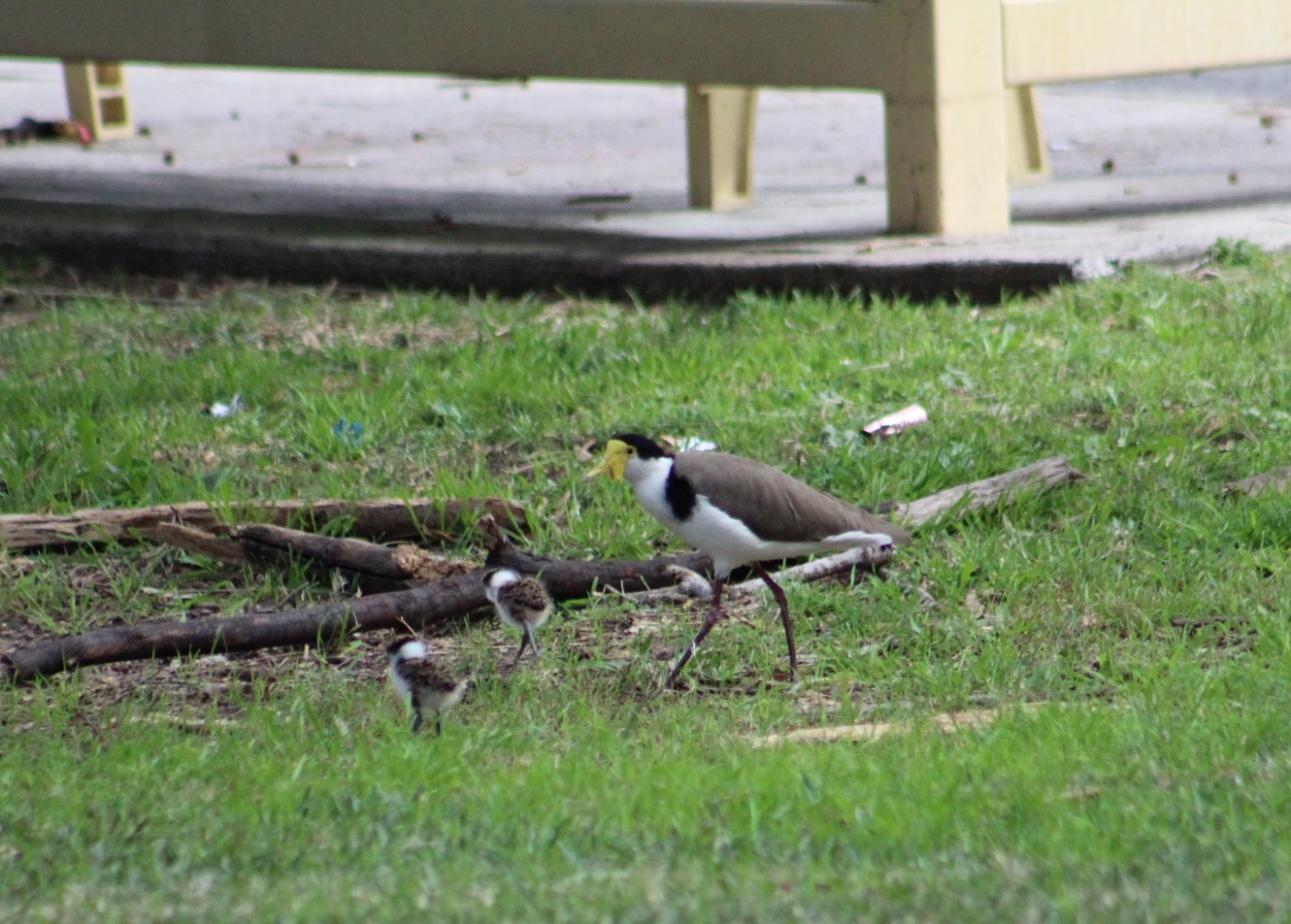
Public Meeting On Northern Beaches Aboriginal Lands Approval By State Government
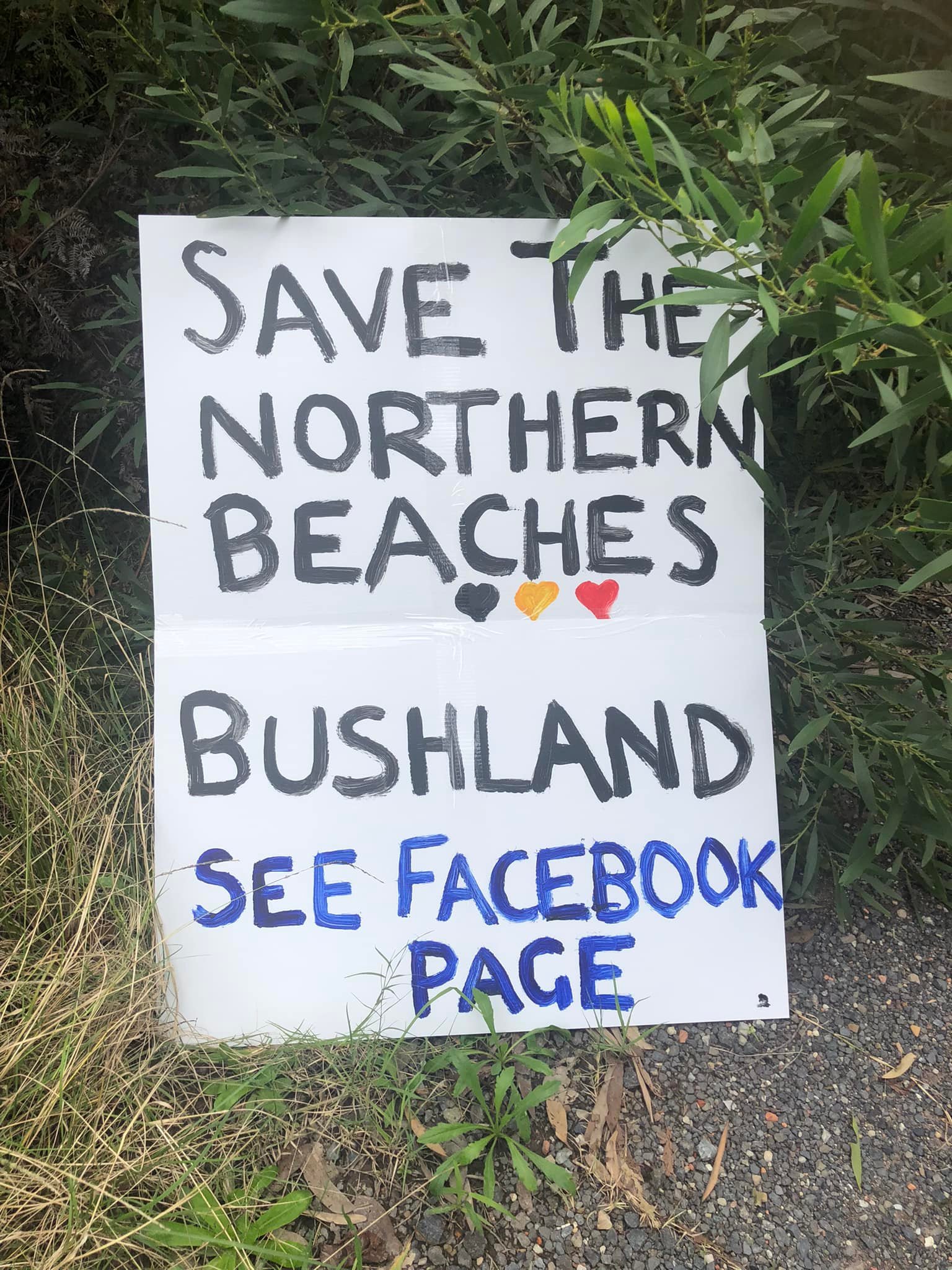
Leopard Seal Visitor
.jpg?timestamp=1660590847423)
Echidna 'Love Train' Season Commences

Dogs Off-Leash On Beaches Open For Feedback
- Calls For Council To Address Dogs Offleash Everywhere After Two Serious Dog Attacks On Local Beaches In Same Week - owner has still not come forward or been identified as of Saturday August 6, 2022
- Sydney Dog Attack Victim Awarded $225, 000: July 2022
- Council Push For Dogs Off Leash On Family Beaches Among Wildlife Habitat
White faced heron landing at north Palm Beach, March 7th, 2022 during storm event. All native birds, reptiles, amphibians and mammals (except the dingo) are protected in New South Wales by the Biodiversity Conservation Act 2016 (BC Act).
Magpie Breeding Season: Avoid The Swoop!
- Try to avoid the area. Do not go back after being swooped. Australian magpies are very intelligent and have a great memory. They will target the same people if you persist on entering their nesting area.
- Be aware of where the bird is. Most will usually swoop from behind. They are much less likely to target you if they think they are being watched. Try drawing eyes on the back of a helmet or hat. You can also hold a long stick in the air to deter swooping.
- Keep calm and do not panic. Walk away quickly but do not run. Running seems to make birds swoop more. Be careful to keep a look out for swooping birds and if you are really concerned, place your folded arms above your head to protect your head and eyes.
- If you are on your bicycle or horse, dismount. Bicycles can irritate the birds and the major cause of accidents following an encounter with a swooping bird, is falling from a bicycle. Calmly walk your bike/horse out of the nesting territory.
- Never harass or provoke nesting birds. A harassed bird will distrust you and as they have a great memory this will ultimately make you a bigger target in future. Do not throw anything at a bird or nest, and never climb a tree and try to remove eggs or chicks.
- Teach children what to do. It is important that children understand and respect native birds. Educating them about the birds and what they can do to avoid being swooped will help them keep calm if they are targeted. Its important children learn to protect their face.
Wanted: Photos Of Flies Feeding On Frogs (For Frog Conservation)

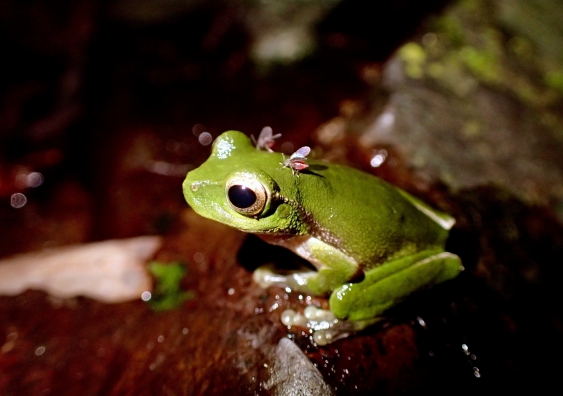
Possums In Your Roof?: Do The Right Thing

Local Wildlife Rescuers And Carers State That Ongoing Heavy Rains Are Tough For Us But Can Be Tougher For Our Wildlife:
- Birds and possums can be washed out of trees, or the tree comes down, nests can disintegrate or hollows fill with water
- Ground dwelling animals can be flooded out of their burrows or hiding places and they need to seek higher ground
- They are at risk crossing roads as people can't see them and sudden braking causes accidents
- The food may disappear - insects, seeds and pollens are washed away, nectar is diluted and animals can be starving
- They are vulnerable in open areas to predators, including our pets
- They can't dry out and may get hypothermia or pneumonia
- Animals may seek shelter in your home or garage.
You can help by:
- Keeping your pets indoors
- Assessing for wounds or parasites
- Putting out towels or shelters like boxes to provide a place to hide
- Drive to conditions and call a rescue group if you see an animal hit (or do a pouch check or get to a vet if you can stop)
- If you are concerned take a photo and talk to a rescue group or wildlife carer
There are 2 rescue groups in the Northern Beaches:
Sydney Wildlife: 9413 4300
WIRES: 1300 094 737
Please be patient as there could be a few enquiries regarding the wildlife.
Generally Sydney Wildlife do not recommend offering food but it may help in some cases. Please ensure you know what they generally eat and any offerings will not make them sick. You can read more on feeding wildlife here
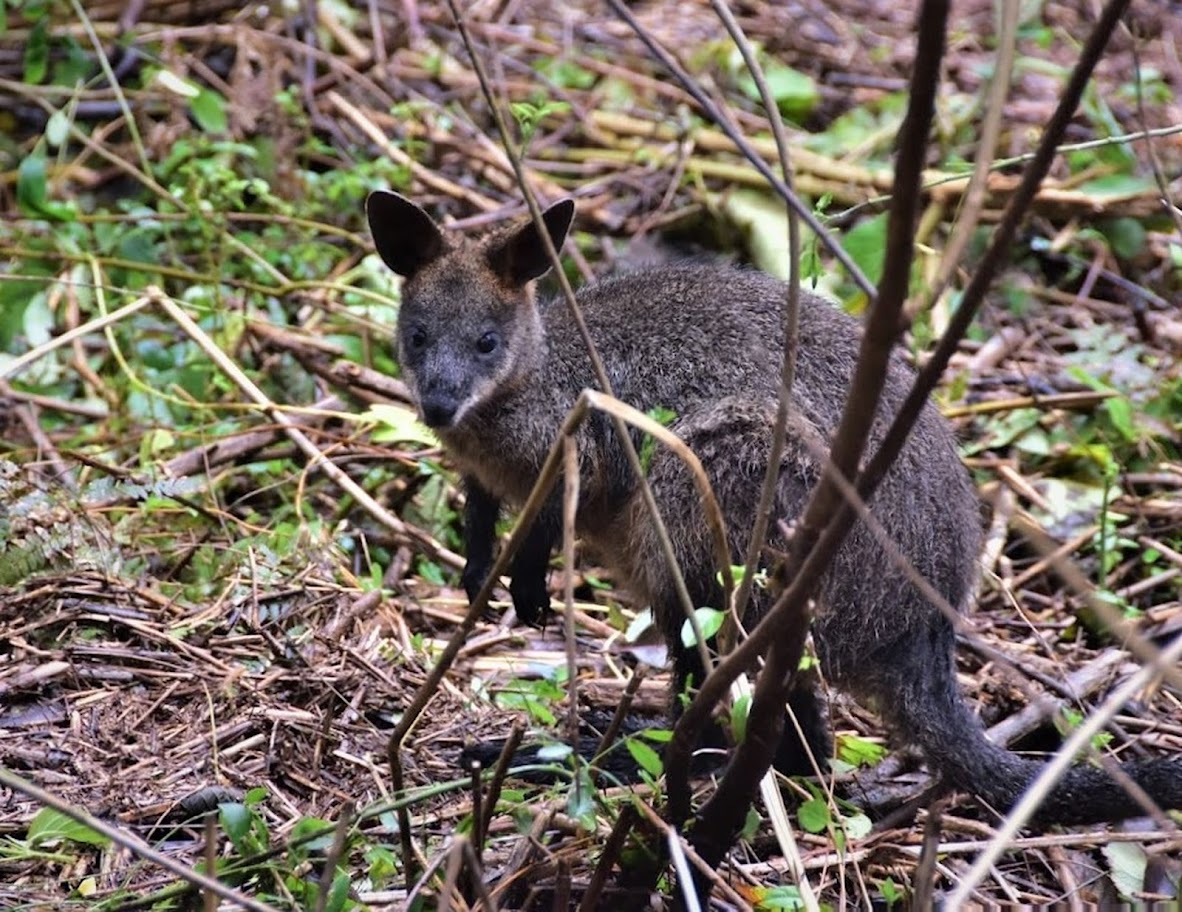
Information courtesy Ed Laginestra, Sydney Wildlife volunteer. Photo: Warriewood Wetlands Wallaby by Kevin Murray, March 2022.
Aviaries + Possum Release Sites Needed

Sydney Wildlife Rescue: Helpers Needed
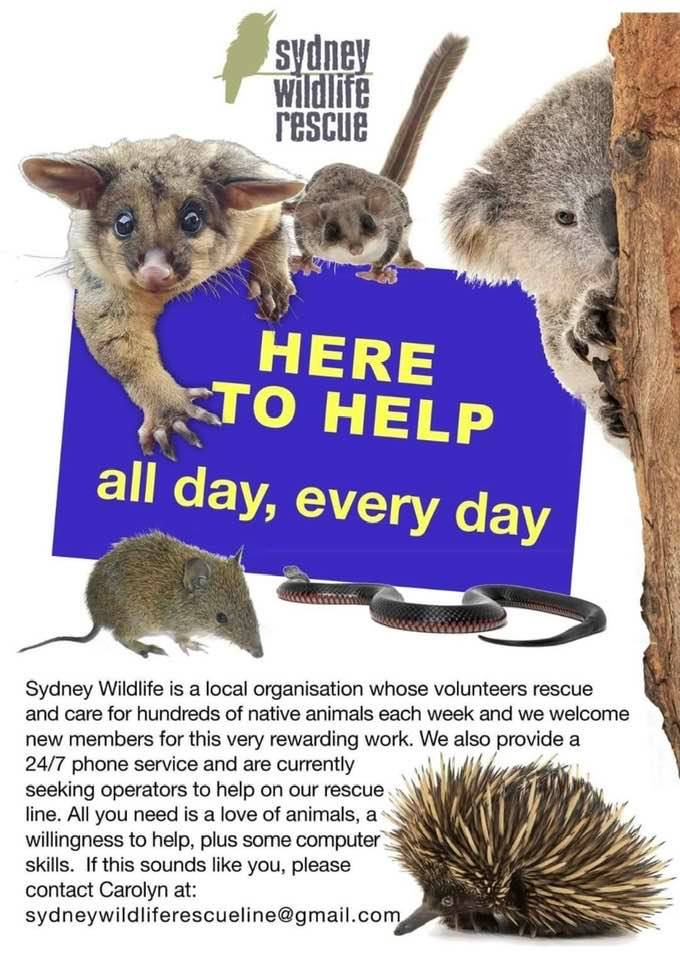
Bushcare In Pittwater
Where we work Which day What time
Avalon
Angophora Reserve 3rd Sunday 8:30 - 11:30am
Avalon Dunes 1st Sunday 8:30 - 11:30am
Avalon Golf Course 2nd Wednesday 3 - 5:30pm
Careel Creek 4th Saturday 8:30 - 11:30am
Toongari Reserve 3rd Saturday 9 - 12noon (8 - 11am in summer)
Bangalley Headland 2nd Sunday 9 to 12noon
Bayview
Winnererremy Bay 4th Sunday 9 to 12noon
Bilgola
North Bilgola Beach 3rd Monday 9 - 12noon
Algona Reserve 1st Saturday 9 - 12noon
Plateau Park 1st Friday 8:30 - 11:30am
Church Point
Browns Bay Reserve 1st Tuesday 9 - 12noon
McCarrs Creek Reserve Contact Bushcare Officer To be confirmed
Clareville
Old Wharf Reserve 3rd Saturday 8 - 11am
Elanora
Kundibah Reserve 4th Sunday 8:30 - 11:30am
 Mona Vale
Mona Vale Mona Vale Beach Basin 1st Saturday 8 - 11am
Mona Vale Dunes 2nd Saturday +3rd Thursday 8:30 - 11:30am
Newport
Bungan Beach 4th Sunday 9 - 12noon
Crescent Reserve 3rd Sunday 9 - 12noon
North Newport Beach 4th Saturday 8:30 - 11:30am
Porter Reserve 2nd Saturday 8 - 11am
North Narrabeen
Irrawong Reserve 2nd Saturday 2 - 5pm
Palm Beach
North Palm Beach Dunes 3rd Saturday 9 - 12noon
Scotland Island
Catherine Park 2nd Sunday 10 - 12:30pm
Elizabeth Park 1st Saturday 9 - 12noon
Pathilda Reserve 3rd Saturday 9 - 12noon
Warriewood
Warriewood Wetlands 1st Sunday 8:30 - 11:30am
Whale Beach
Norma Park 1st Friday 9 - 12noon
Western Foreshores
Coopers Point, Elvina Bay 2nd Sunday 10 - 1pm
Rocky Point, Elvina Bay 1st Monday 9 - 12noon
Gardens And Environment Groups And Organisations In Pittwater
Plibersek Wins Federal Court Backing To Destroy Habitat Of Critically-Endangered Species In Gelorup Corridor: Roads Plan Ignores Already Cleared Land Alongside
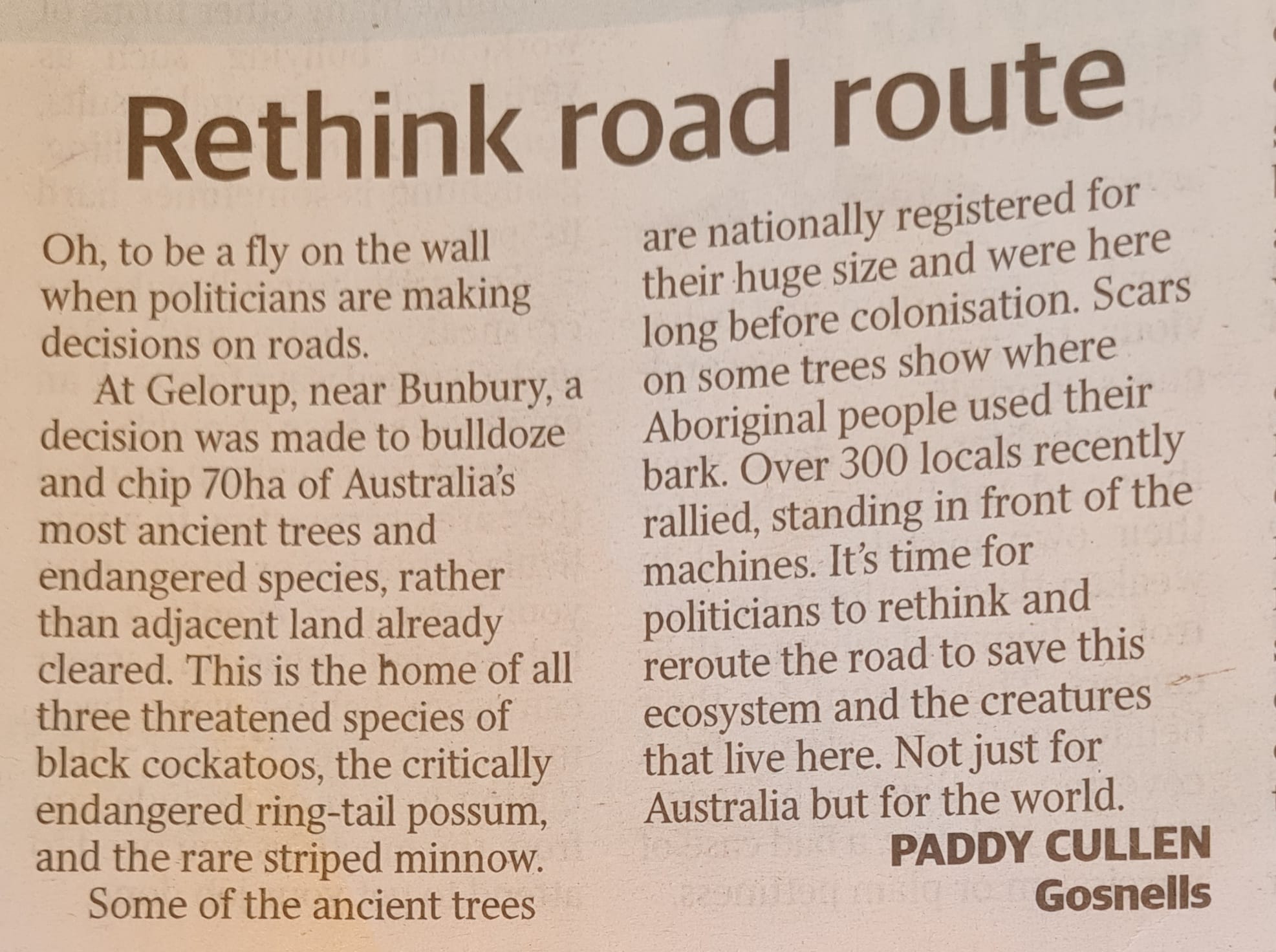
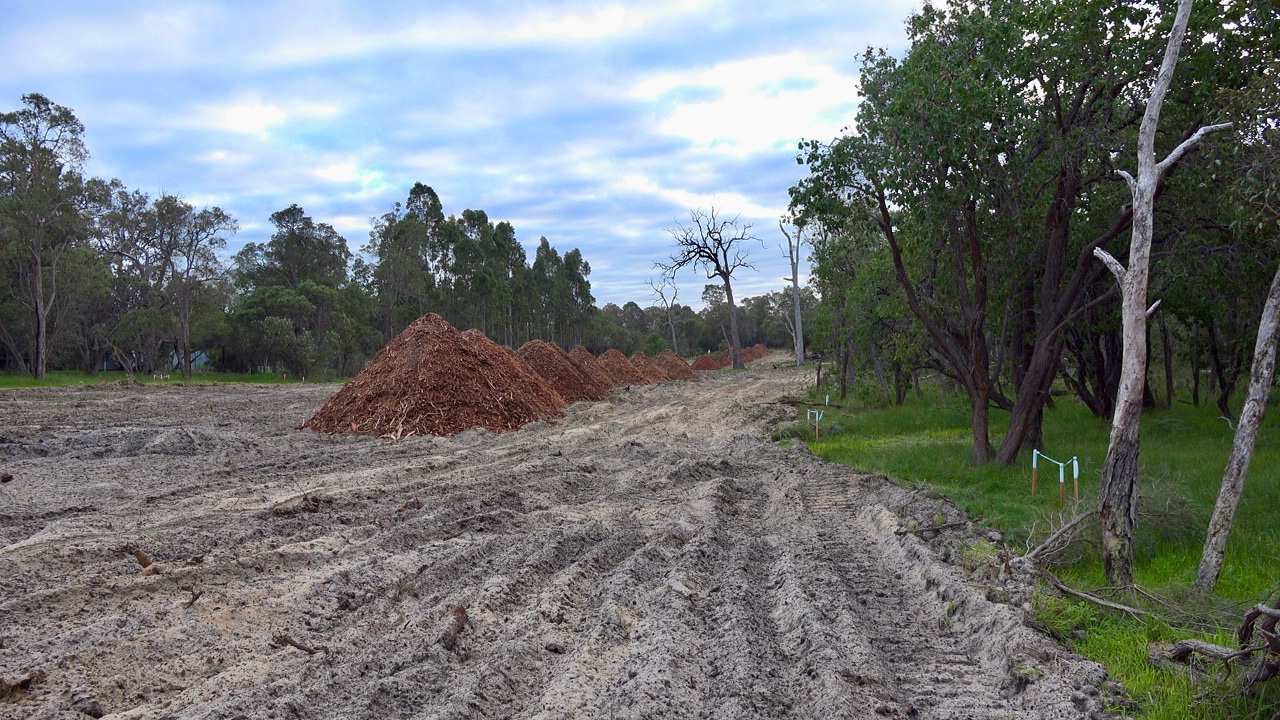
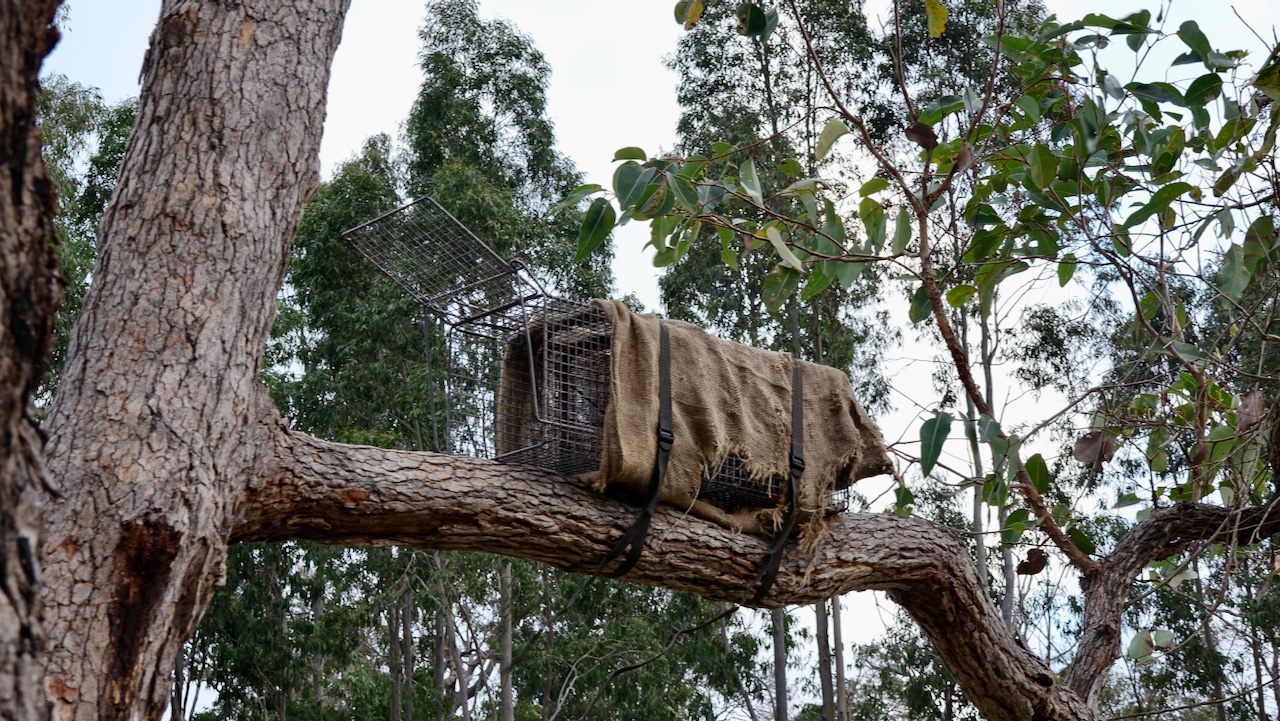

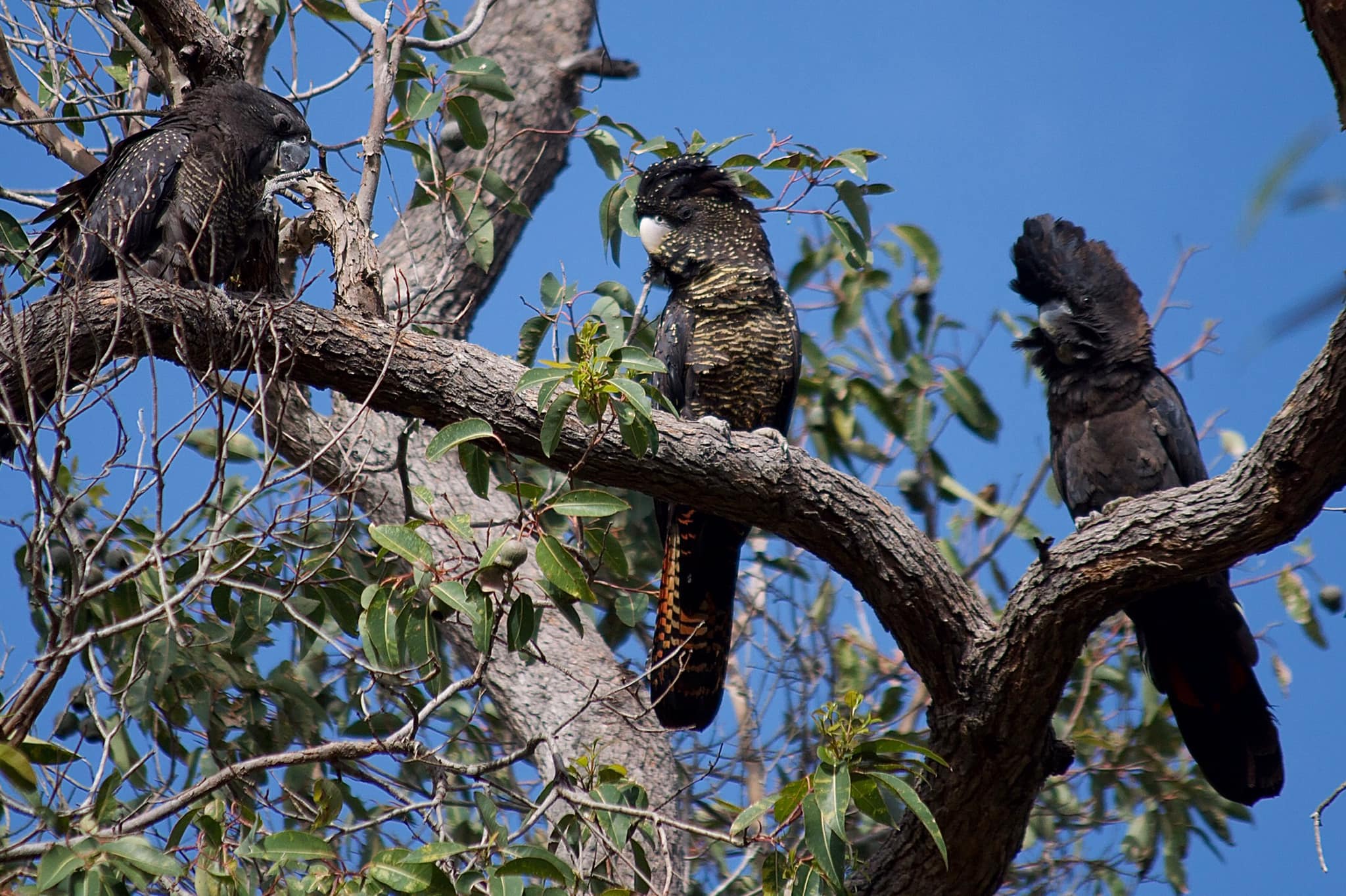
Formal Consultation On Safeguard Mechanism Reform Opens
- setting baselines for existing and new facilities;
- setting indicative rates for baseline decline;
- lowering costs through crediting over performance and the use of offsets;
- identifying options for tailored treatment for emissions-intensive, trade-exposed businesses; and
- taking account of available and emerging technologies.
Dungowan Dam Evauluation 'Costs Far Outweigh Any Benefit'
'While the New Dungowan Dam and Pipeline will have community benefit and increase resilience, it is a significant infrastructure intervention with costs that far outweigh the benefits that will be delivered. Based on our assessment, the Increased Urban Reserve option (Chaffey Dam), which is also considered in the business case, appears to be a feasible, lower cost solution that addresses the problem and warrants further detailed consideration.'
Infrastructure Australia has finalised its independent assessment of the business case for the New Dungowan Dam and Pipeline in accordance with the Infrastructure Australia Assessment Framework. The proposal has not been added to the Infrastructure Priority List at this time.The New Dungowan Dam and Pipeline aims to increase town water supply for Tamworth and maintain water reliability for agricultural production in the Peel Valley. The proposal was developed in response to long periods of drought and water restrictions. At a time in 2019, Tamworth was 12 months away from running out of water from its primary water source, the Chaffey Dam.The project has a capital cost of more than $1 billion and a benefit cost-ratio of just 0.09. Although it offers sustainability and resilience benefits, our assessment found that similar community benefits could be achieved through a combination of lower cost build and non-build options.This includes increasing the amount of water from Chaffey Dam that is available for urban use, along with policy changes such as demand management and water use efficiency measures.We would welcome a revised business case for an investment solution that better aligns to the identified problems and opportunities for providing increased water security to the Tamworth region.Infrastructure Australia Chair Col Murray declared a conflict of interest in relation to this project and was not present during any discussion or decision-making relating to the business case assessment, in line with Infrastructure Australia’s Conflict of Interest Policy.
''The option has been recommended on the basis that “the other options do not develop new capacity and therefore focus on shifting the burden of the existing level of service, which is expected to decline, between different stakeholders either within the Peel Valley or Namoi region.” This is inappropriate, as the problem that has been identified is the need to address Tamworth’s water security risk (i.e. access to water), rather than increasing the storage capacity in the region. Economic analysis of the three options presented in the business case demonstrates that the water security risk is more efficiently addressed by options that do not involve the development of new capacity. The Increased Urban Reserve option returns a significantly better BCR and NPV result than the other shortlisted options, outperforming the New Dungowan and Pipeline option in terms of the quantified benefit from improved water security ($3.85 million compared to $3.43 million).The recommendation of the preferred option is based primarily on the outcomes of a Strategic Merit Test, which has not been well explained. Specifically, the Increased Urban Reserve option scored poorly in relation to investment decision readiness and stakeholder acceptance. This is not supported by the results of the cost-benefit analysis or other information in the business case. In relation to the risk associated with stakeholder acceptance, the cost-benefit analysis includes quantification of the disbenefit attributable to the reduced reliability of supply for irrigators in the Peel Valley. This disbenefit is quantified at only $660,000 in PV terms under the Increased Urban Reserve option. This indicates the adverse impact on irrigators is highly likely to be mitigable at low cost.Compensation to non-urban users was not considered in the Increased Urban Reserve option. In addition, the poor performance of this option in terms of investment readiness gives insufficient consideration to the lack of infrastructure required to implement it, whereas the New Dungowan Dam and Pipeline option would not be completed until 2029.Further assessment, including hydrological, economic, and ecological analysis, will provide greater understanding of the feasibility of the Increased Urban Reserve option. Hence, having regard to the results of the cost-benefit analysis and justification of the assessment of the shortlisted options in the Strategic Merit Test, the identification of the New Dungowan Dam and Pipeline option as the preferred option appears inappropriate. The Increased Urban Reserve option achieves greater benefits at significantly lower economic cost, with limited deliverability risk.
- Local water utility and Domestic and Stock water access licence holders received an allocation of 70% of entitlement.
- High security water access licence holders in the Peel Regulated River water source and its sub categories received an allocation of 50% of entitlement.
- General security water access licence holders received an allocation of 0% of entitlement.
- All local water utility and Domestic and Stock water access licence holders in the Peel Unregulated River, Peel Alluvium and Peel Fractured Rock water sources received an allocation of 100% of entitlement.
- In the Peel Alluvium water source, aquifer access licence holders received an allocation of 100% of entitlement, while aquifer (general security) access licence holders received an allocation of 51% of entitlement.
- Peel Unregulated River water access licence holders received an allocation of 100% of entitlement.
- Aquifer access licence holders in the Peel Fractured Rock water source received an allocation of 100% of entitlement.
Water For Brewarinna Update (February 2020 Community News Page)
#YaamaNgunnaBaakaBusy couple of days delivering 15L water bottles throughout the Brewarrina Community especially to the Elders and those on dialysis.Hopefully this will go some way to helping the people before clean drinking water becomes available again. Those of you with water bottles please keep for refills, we don’t want to have plastic waste #SavingOurWater #NoPlasticWasteSpecial thanks to-Neil and the Northern Beaches mob- and Robert and staff from IGA in Bourke for their support.

- Yamma Ngunna Baaka - From The Northern Beaches To Bre: Our Sister City Shares Its Water Woes - October 2019
- Water Activists United Call At Newport Meeting For Greater Flows In The Baaka – The Murray-Darling Basin - November 2019
- Christmas Appeal Launched For Aboriginal Kids In Sister City Brewarrina - November 2019
- Narrabeen Bridge Protest Demands Water For Rivers - March 2020
Wilcannia Weir Project Delivers Water And Jobs
Miner MMG Remove Machines From Tasmania’s Forests Under Environmentalists Supervision
Climate Driver Update - Wet Outlook Continues With An Increased Chance Of La Nina Developing This Spring
Governments And The Healthcare Sector Must Lead On Climate Change AMA And DEA Say
- A net zero Australian healthcare system by 2040 with majority of emission cuts by 2030.
- The development of a national climate change and health strategy to facilitate planning for climate health impacts, which the federal government has committed to.
- Establishing a National Sustainable Healthcare Unit to support environmentally sustainable practice in healthcare and reduce the sector’s own emissions.
- Education of current and future doctors to:
- be well equipped to care for patients and populations impacted by the adverse health effects of climate change, and
- provide sustainable health care to support sector-wide emissions reduction.
- Collaboration on climate change mitigation strategies with populations most at risk of climate-related adverse health impacts, such as Aboriginal and Torres Strait Islander peoples.
Applications Now Open For 2022 Gone Fishing Day Grants
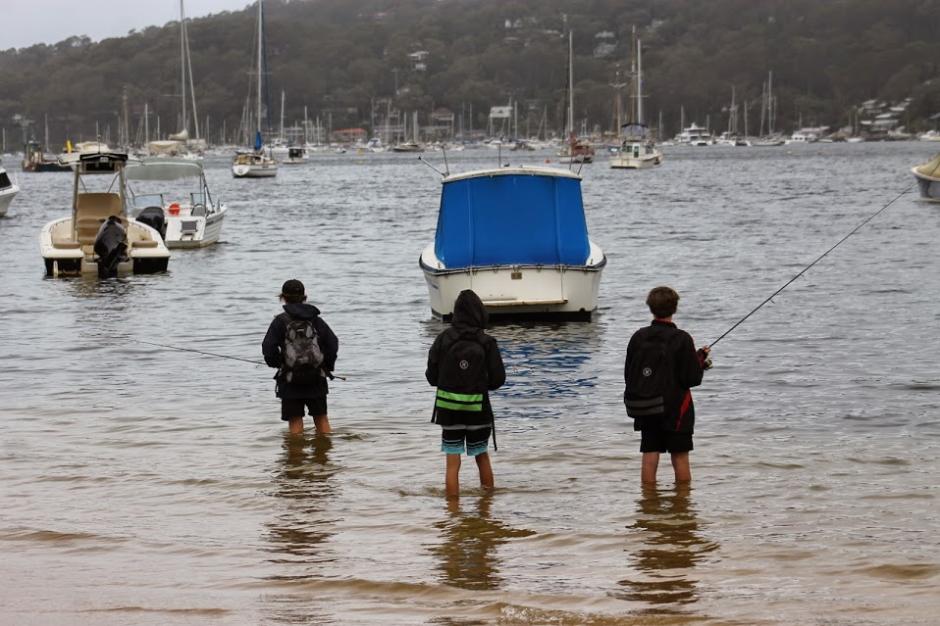
It’s Raining PFAS: Even In Antarctica And On The Tibetan Plateau Rainwater Is Unsafe To Drink
Wildlife recovery spending after Australia’s last megafires was 13 times less than the $2.7 billion needed

Few could forget the devastating megafires that raged across southeast and western Australia during 2019-20. As well as killing people and destroying homes and towns, the fires killed wildlife and burnt up to 96,000km² of animal habitat – an area bigger than Hungary.
Under climate change, megafires will become increasingly common. This is likely to leave many species needing help at the same time, over vast areas. So our new research, released today, devised a way for conservation scientists and others to determine which actions, and where, will best help wildlife recover.
We also put a price tag on these measures. We found about A$2.7 billion should have been spent across Australia in the year after the megafires to mitigate all threats to 290 severely affected threatened animal and plant species. This is almost 13 times the funding dedicated by the former federal Coalition government.
The paltry spending means many species severely harmed by the megafires were left in desperate trouble, potentially pushing some closer to extinction.
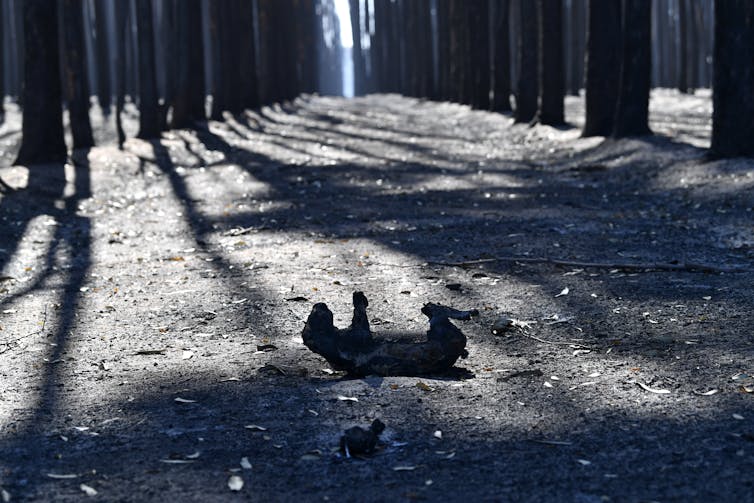
The First Year Is Crucial
Many plant and animal species are especially vulnerable in the first year after a fire.
Fires can allow invasive weeds to invade and dominate burnt areas. This can hinder the ecosystem’s recovery, including making it more fire-prone.
Many native animals such as Kangaroo Island dunnart and long-footed potoroo rely on vegetation cover to avoid invasive predators such as feral cats and foxes. When fire removes this vegetation, native animals have nowhere to hide.
After a fire, any patches of unburnt vegetation are crucial for animals that survived. But invasive herbivores such as horses, deer, and pigs can graze on these food sources, leaving little for native wildlife.
For these reasons, the first year after a fire is usually the most important time to implement actions to help vulnerable species recover. Such actions can include:
- protecting habitat
- managing invasive plants and animals
- stopping native forest degradation associated with logging
- limiting damage from recreation activities
- managing disease.
But in the immediate aftermath of a fire, how do conservation scientists and others decide which species to help, and how? Which locations should they prioritise? And how does all this interact with other threats to wildlife such as land clearing and feral predators?
To date, decision-makers around the world have largely used a method known as the “site richness” approach to prioritise conservation actions. This approach concentrates actions in locations where the greatest number of species can be recovered.
But this approach can mean some high-risk species may not get the help they need, while other less critical species receive disproportionately high assistance.
For example, research from China has showed relying entirely on this method meant species of woody plants found only across a small range – and therefore potentially vulnerable – missed out on conservation actions.
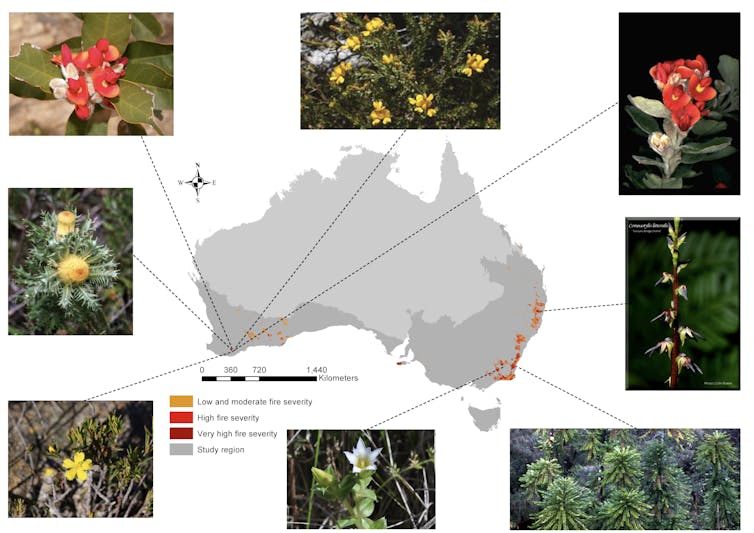
Our New Approach
Our new research devised and assessed an alternative method. Known as the “complementarity” approach, it ensures conservation actions occur across the habitats of all threatened species. It involves combining data about:
- the distribution of species and threats
- fire extent and intensity
- a species’ risk of severe, irreversible decline after a fire.
From that, decisions can be made about which of the 22 conservation actions should be carried out first, and where. It prioritises locations where threats affect multiple species – making it more cost-effective to deal with them – and where actions at one site can be easily extended to nearby areas.
We then applied our framework to the 2019–2020 bushfires to identify the most at-risk species, the actions needed to save them, the best locations for these actions, and the costs.
Our approach identified 290 threatened species needing immediate conservation attention. They spanned mammals, birds, reptiles, frogs, insects, and plants.
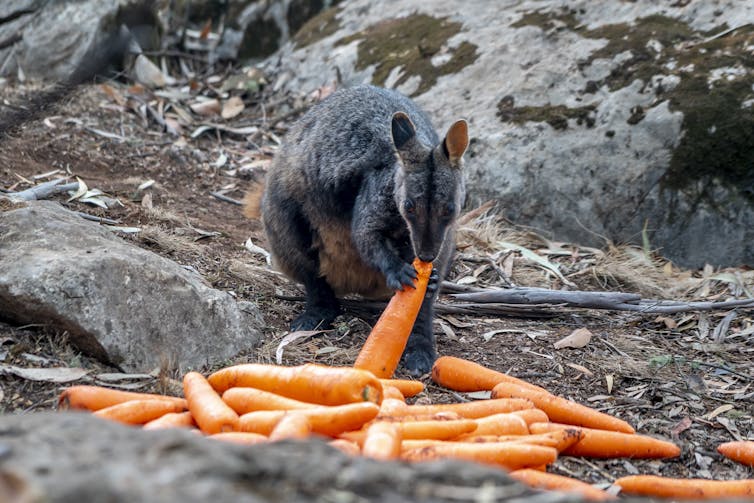
Each species required, on average, three conservation actions to mitigate threats. The top three were habitat protection (all species), fire suppression (57% of species) and invasive plant management (36% of species).
We then prioritised cost-effective actions after the fires, using our approach. We found actions should take place in 179 geographic areas, including the Snowy Mountains in New South Wales and Gippsland in Victoria.
Actions in these regions recovered the highest number of at-risk species – such as koalas, greater gliders and regent honeyeaters – for the least cost.
We found A$2.7 billion would be needed to mitigate all threats to 290 species in the year after the megafires.
But the previous federal government committed just $200 million to post-fire recovery actions. Some $50 million of this was delivered relatively quickly. But the remainder was to be delivered over two years from July 2020 – beyond the timeframe in which many species required urgent help.
Heeding The Lessons
Our research shows the potential gains from alternative approaches to conservation after devastating fires. It also underscores the need for adequate government funding, delivered quickly, to help species most in need.
It’s worth remembering the loss of habitat from bushfires often compounds decades of land clearing. As Australia faces an ever-worsening bushfire risk, we urge Environment Minister Tanya Plibersek to prevent further loss of threatened species habitat.
Michelle Ward, Postdoctoral research fellow, The University of Queensland; Ayesha Tulloch, ARC Future Fellow, Queensland University of Technology, and James Watson, Professor, The University of Queensland
This article is republished from The Conversation under a Creative Commons license. Read the original article.
No, not again! A third straight La Niña is likely – here’s how you and your family can prepare
Mel Taylor, Macquarie University and Katharine Haynes, University of WollongongHearts sank along the Australian east coast this week when the Bureau of Meteorology announced a third consecutive La Niña was likely this year. La Niña weather events typically deliver above-average rainfall in spring and summer.
But the last two La Niñas mean our catchments are already full. Dams are at capacity, soils are saturated and rivers are high. In some cases, there’s nowhere for the rains to go except over land.
Over the past 18 months, many communities have been hit by floods – some more than once. For these residents, the prospect of a third La Niña will be extremely concerning. And some people who’ve never experienced floods may now be at risk.
Our current research project is examining the experiences of flood-hit communities in New South Wales and Queensland – and our interviews have already yielded useful insights. So let’s take a look at what we should be thinking about now as another wet summer looms.
Water Isn’t Always Fun
Floods are among the deadliest natural hazards in Australia. Yet in Australian culture, water often equates to fun. From a young age we’re taught to swim, enjoy and “master” the dangers that water poses.
So during floods we often see risky behaviours such as driving and playing in dangerous water.
Recent floods, however, brought home the reality of the threat. Few could forget images of frightened families being winched off roofs by helicopter, water rushing from spilling dams and everyday people rescuing their neighbours.
The NSW government on Wednesday released an independent report into this year’s floods. It examined flooding from February to April and again in July – mostly around the Northern Rivers, Sydney’s Hawkesbury-Nepean and the central to north coasts.
The report contained troubling statistics, including:
- nine people tragically died
- 7,700 people sought emergency accommodation
- 14,600 homes were damaged
- 5,300 homes were left uninhabitable.
Releasing the report, NSW Premier Dominic Perrottet said up to 40,000 Western Sydney residents risked flood evacuation by 2040, if flood conditions similar to those in July were repeated and no mitigation action was taken.
The inquiry revealed a central theme: the need for a renewed and stronger emphasis on sustained disaster preparedness. Otherwise, as the report noted, the emergency response becomes harder:
Preparedness is discussed in relation to emergency management and our natural and built environment. But an important component of preparedness is at a personal or family level. Failure to prepare at this level makes preparations at other levels more difficult and expensive.

‘Don’t Worry. Your House Won’t Get Wet’
Our current research is examining the experiences of those affected by this year’s floods to gather insights on preparedness and response. Participants can take part in an interview, a survey or both.
Our interviews are already providing useful insights. They include the possibility that prior experience of flood, and the well-meaning reassurances of others, can hinder preparations. As one respondent said:
the house, having been built on a mound, has never been flooded and that’s why my neighbour said, ‘Don’t worry. Your house won’t get wet. It’s never got wet in 70 years’. But this was unprecedented.
With another wet summer likely, interviewees are starting to see major flooding as a “new normal” rather than a once-in-a-lifetime experience. This is causing them to question the future of their communities. As another respondent told us:
that’s the part that I’m struggling with now is that it feels like it’s unviable to live here because there’s no security, and when you take away people’s security, your life tends to unravel.
We hope our research will influence policy and practice on flood preparation, community engagement and risk messaging, and shed light on more permanent changes required.
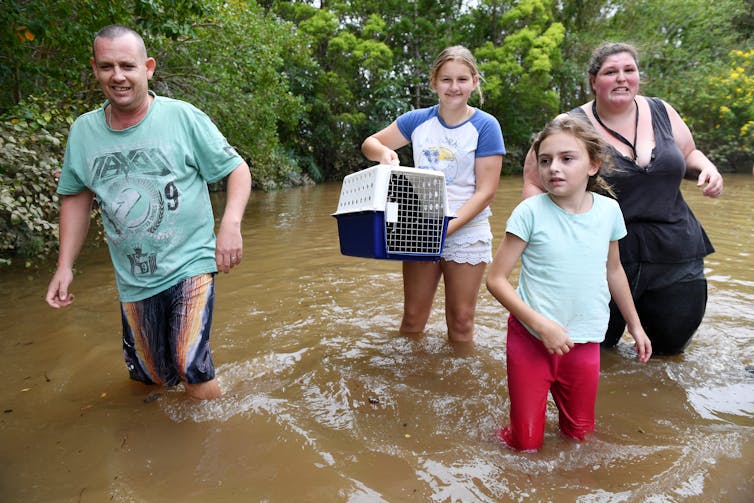
Be Prepared
So what should you do if flooding is forecast and you need to evacuate? Here’s what experts recommend:
identify the safest route to your nearest safe location and leave well before roads flood
move vehicles, valuables, outdoor equipment, garbage and poisons to higher locations
enact safety plans for pets and other animals
take medications and identification with you
tell friends, family and neighbours of your plans
know where to go for information. Monitor alerts and stay aware of changing situations
keep your mobile phone charged and have at least half a tank of fuel in your vehicle
turn off electricity, gas, and water at the mains before you leave.
Of course, flood preparation should not be left until the last minute. Now is a good time to think about what might happen in the months ahead. Things you can do now include:
clean up outside and inside, move or secure items that could float or create a hazard
move valued possession to higher places in your home
pack an emergency bag and keep it at the ready
consider which friends or family you might stay with if needed.
For further advice, head to the website of your state’s emergency service agencies.
Thinking Long-Term
Climate change will exacerbate floods and other natural hazards. Communities must be supported to prepare as best they can.
More permanent measures are also needed, such as land buybacks to move people out of flood-prone areas. And importantly, planning systems must ensure we don’t keep building on floodplains.
Our approach to disaster readiness will continue to change. Already, experts are providing advice on matters such as emotional preparedness and recovery in the aftermath.
One thing is clear: in the face of the increasing disaster threat, temporary and seasonal preparations are no longer enough. ![]()
Mel Taylor, Associate Professor, Macquarie University and Katharine Haynes, Honorary Senior Research Fellow, University of Wollongong
This article is republished from The Conversation under a Creative Commons license. Read the original article.
Drought: five ways to stop heavy rains washing away parched soil
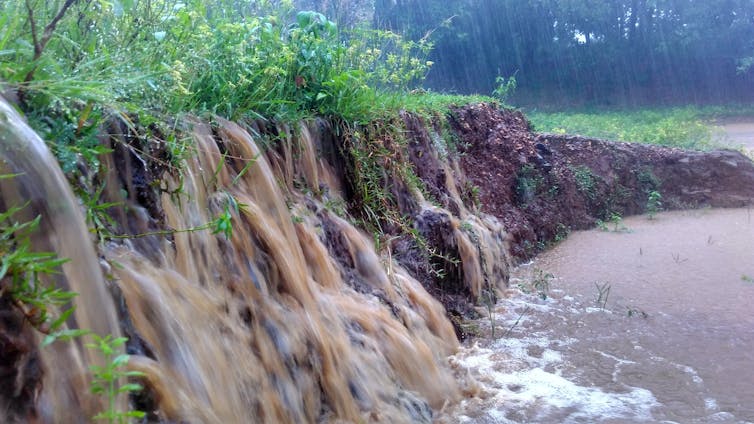
When William Blake described England’s “green and pleasant land” in his poem Jerusalem, he was actually writing during a prolonged drought. Two centuries later, much of Europe is withering under successive heatwaves amid one of the most extreme droughts ever recorded.
The latest satellite image of England captured by Nasa shows not a green and pleasant land but one which is brown and parched. Under all that dry vegetation is sun-baked, dusty and desiccated soil.
Heavy rain and thundery showers are now forecast for much of the UK. No doubt the promise of a good downpour will please farmers, for whom the drought has been particularly punishing. Bizarrely though, heavy rain may not be what their thirsty soil needs right now.
A soil normally acts like a sponge which soaks up moisture when it rains. Having been baked for weeks by intense heat with little respite, soil surfaces have hardened.
As a result, the soil’s infiltration capacity (the maximum rate at which soils can absorb moisture) has diminished. If rain falls at such an intensity that this rate is exceeded, the water will run off the soil surface, potentially triggering flash floods and other hazards downslope.
When heavy rain falls, tonnes of soil can be eroded into the flow and rushed out of farm gates. There, it is washed into rivers, and spat out to sea in a brown plume that can occasionally be seen from space.
Likewise, flash floods can leave thousands of households with thick carpets of sand, silt and clay. Cleaning up after extreme rainfall can drain wallets very quickly, but there is a larger and longer-term cost.
Soil erosion is a major threat to the resilience of the environment. Proactive measures to curb erosion are essential to ensure soils continue supporting food production, sustaining habitats and biodiversity, cycling nutrients and safely storing the carbon fuelling climate change.
Here are five options for preventing soil running off the land.

1. Don’t Leave Soils Bare
A bare soil is particularly vulnerable to erosion. Extreme heat can make some harvests come early, leaving soils bare for longer. Farmers can grow cover crops such as brassicas, legumes and grasses to protect soils from being exposed between periods of crop production.
As well as shielding the soil from rain splash, some cover crops can suppress weeds and fungal diseases, replenish carbon and offer food and habitat to wildlife.

2. Adapt Tillage Practices
Soil tillage (digging, stirring and overturning it) is one of the most practised methods of preparing the land for growing crops. But tilling the soil too vigorously can damage its internal structure.
A healthy soil has a continuous network of pores and channels capable of storing and transporting air and water. Lining this network are mineral and organic aggregates. Maintaining the soil’s structure is vital, not only for bolstering its resistance to erosion, but for enhancing how much water can infiltrate it.
Shifting towards less intensive tillage practices – reduced or zero tillage farming – has been shown to be effective at curbing soil erosion. Ploughing across slopes rather than down them can reduce it even further.
3. Watch Out For Overgrazing
Grazing livestock like cattle can maintain grassland habitats and support native wildlife, but overgrazing can be a problem. If vegetation is stripped from the land faster than it can naturally recover, soils are left bare and prone to erosion.
Overgrazing can also compact the soil, making it less effective at soaking up moisture and increasing the likelihood that water will run off the surface.

4. Consider Terracing Steep Slopes
Steep slopes funnel water downhill fast. Building a series of level steps into the slope where food can be grown, a practice known as terracing, is an effective engineering solution.
Hillslope terracing has been adopted by farmers for millennia, and can be particularly good at reducing water runoff and sediment erosion, especially if regularly maintained. Levelling the slope can also help water infiltrate the soil and increase how much water it can hold.

5. Grow A Buffer Strip
For fields bordering rivers and streams, planting buffer strips of vegetation on the boundary with the watercourse can offer multiple benefits beyond reducing soil erosion.
Comprised of grass and shrubs, buffer strips increase the roughness of the land which slows the water running off it. Planting trees in buffer strips can help stabilise riverbanks, shade livestock and reduce the runoff of agricultural chemicals into rivers. As well as combating soil erosion, buffer strips feed and shelter pollinating insects, enriching a farm’s biodiversity.
Be Proactive Not Reactive
It only takes a second to open an umbrella and protect yourself from a downpour. Protecting soil from erosion demands more proactive measures.
These five recommendations can build a soil’s resistance to erosion, particularly during the spells of heavy rain which often follow heatwaves. If implemented and maintained, these strategies can have lasting additional benefits for soil fertility, biodiversity and slowing climate change.![]()
Dan Evans, 75th Anniversary Research Fellow, Soil and Agrifood Institute, Cranfield University
This article is republished from The Conversation under a Creative Commons license. Read the original article.
1 in 4 Australians is lonely. Quality green spaces in our cities offer a solution

One in four Australian adults feel lonely, and the impacts can be dire. Loneliness increases our risks of depression, diabetes, dementia, self-harm and suicide. But likening it to a disease and proposals to treat it with a pill miss the point: we’ve been building for loneliness over many decades and decision-makers have been asleep at the wheel.
Having studied the issue, we view loneliness as largely a product of our environment – what we call a “lonelygenic environment” – not a disease or a problem with any particular individual. So what is this “lonelygenic environment”?
Over decades, our cities have become sprawling low-density agglomerations. Many places are too far to walk from home. Short errands are routinely done by car, erasing opportunities to stop and chat with locals.
Large-scale felling of street trees has not only obliterated natural shade, but severed our connection with the “more than human” world. Car traffic dominates residential roads, which are also clogged with parked cars.
We have lost the people-friendly streets that we once used for regularly gathering, playing and celebrating with neighbours. No wonder we now know so few by name.
If the determinants of loneliness are largely environmental, so too must be the solutions. Yet we hear so little about this.
How Much Difference Can Green Space Make?
In a previous Conversation article, we suggested investing in public green space is part of the solution to the epidemic of loneliness. The article was based on our longitudinal study that reported a greening target of 30% local landcover could cut the odds of becoming lonely by a quarter. Among people living alone, who tend to be more vulnerable to loneliness, green space cut those odds by up to a half.
But how can green space reduce loneliness? That’s the focus of our new review of studies from around the world. Two-thirds of the studies found green space potentially protected people against loneliness.
Our review identified multiple pathways for reducing loneliness. These included:
- building capacities for connection with community
- restoring our sense of belonging and connection with nature
- reducing harms, such as violence, that may otherwise lead to loneliness.
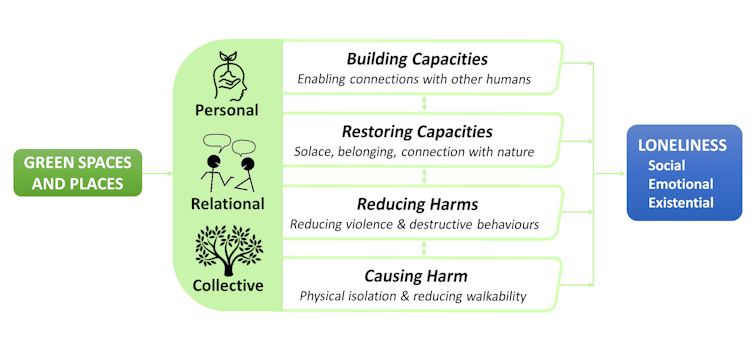
The Quality Of The Green Space Matters
During the COVID-19 pandemic we undertook a nationally representative survey and found the odds of connecting with neighbours were five times higher for people who visited high-quality green space than for those who didn’t or couldn’t.
Related benefits were also much stronger if green spaces were higher quality. For example, exercise and relief from stress were both more commonly reported by people visiting higher-quality green spaces.
Quality was defined by participants’ views on things such as access, aesthetics, facilities, incivilities (e.g. litter, disrepair) and safety. Perceptions are important because the qualities of a green space need to resonate for people to visit them.
Regular visits to green spaces foster attachment and belonging. These spaces permit quiet contemplation in solitude, but also bring people together and connect people with nature. They become revered as settings for gatherings, bonding, cheering and shared memory-making.
By encouraging relaxation and playfulness – which can be frowned upon in other settings – green spaces may also enable connection for people who otherwise find it difficult, such as those with highly introverted personalities.
The psychologically restorative benefits of green space are now well-documented. Green spaces such as healing gardens can serve as therapeutic landscapes, offering refuge and respite for those experiencing loneliness, which can stem from some form of trauma. While usually provided for patients, these settings might also offer sanctuaries for health professionals experiencing burnout.
The bottom line is that higher-quality green space maximises opportunities for both social connection and health. While our previous research and other studies highlight inequities in access to green space, we must pay even more attention to inequities in the quality of green space.
Consult Communities To Get It Right
This may all sound like we think the impacts of green space are universally positive; we don’t. For instance, many studies in countries such as Denmark, Poland and New Zealand report that some people with disabilities, who are already vulnerable to loneliness, face significant barriers to visiting green spaces and may feel “out of place” within them.
Other research indicates that the creation or regeneration of green spaces in communities may be associated with disempowerment and dispossession, by making nearby housing less affordable.
In other words, a nearby green space that is highly attractive and a source of joy for some people may for others be a symbol of processes that aggravate loneliness and perpetuate misery.
That is why community views on the design of green space really matter. Consultation is key to ensure everyone feels meaningfully engaged in the process.
Our program of work, and our new review in particular, shows green space qualities depend on the context, preferences and needs of local residents. It is clear we need local networks of green spaces that provide something of value for everyone.
Finally, the process of urban greening itself can help counter loneliness by empowering communities to actively participate in creating and maintaining local green spaces. This has been done successfully over decades by the Royal Botanic Garden Sydney’s Community Greening program. By bringing people together to create green spaces, the garden has been quietly showing us the solution to our lonelygenic environment all along.![]()
Xiaoqi Feng, Associate Professor in Urban Health and Environment; NHMRC Career Development Fellow, UNSW Sydney and Thomas Astell-Burt, Professor of Population Health and Environmental Data Science, NHMRC Boosting Dementia Research Leadership Fellow, University of Wollongong
This article is republished from The Conversation under a Creative Commons license. Read the original article.
Australia may be heading for emissions trading between big polluters

Could Australia soon have a form of emissions trading? Yes, if Labor’s much-anticipated paper on fixing Australia’s mediocre emissions-reduction framework, released today, is any guide.
At present, Australia relies on the controversial safeguard mechanism to encourage big emitters such as fossil fuel power plants and manufacturers to reduce their pollution. This framework – alongside the Emissions Reduction Fund – was introduced during the Coalition years to reduce carbon dioxide pollution at low cost.
The problem is, it didn’t work. Emissions from large polluters have remained high since it was introduced in 2016. As the discussion paper states:
Emissions limits, known as baselines, have allowed business-as-usual operations and aggregate emissions from Safeguard facilities to grow.
Labor’s discussion paper flags ways to make the mechanism work as intended – most significantly by letting companies sell credits created by cutting emissions by more than they are required to. Companies finding it harder to slash emissions can buy these. Creating this market would effectively create a very useful carbon currency.
You might think this sounds abstract. It’s not. Fixing this mechanism would have a major impact on our future emissions – and the likelihood of reaching our committed emission goals. Getting this right matters.

So What Is The Safeguard Mechanism And Why Does It Matter?
The safeguard mechanism is a framework to control emissions from large polluters – defined as those emitting more than 100,000 tonnes of carbon dioxide equivalent annually.
This includes industries such as electricity generation, mining, and oil and gas extraction.
It works by giving each facility a benchmark level of emissions they are not allowed to exceed.
If a facility does exceed their benchmark, the regulator gives them a few easy options: reduce emissions, ask for their benchmark to increase, or buy and surrender Australian Carbon Credit Units. These credits come from someone else’s emissions reductions, which the original polluter has to pay for.
The problem is the current safeguard mechanism is not fit for purpose.
As I’ve previously pointed out, the system is easily gamed. Many high-polluting firms have simply asked for larger benchmarks – and often got them. You can see the incentive – asking for a larger, “better fitting” benchmark is the cheapest option of all, requiring absolutely no change on the company’s part.
This is the fundamental flaw: there is no economic incentive for large polluters to cut their emissions.
Better systems already exist in other countries. For instance, large polluters in the United States and European Union are targeted using pollution markets that have robust economic incentives.
In such schemes, companies that find it very expensive to reduce pollution can buy pollution credits from the market. Alternatively, companies that find it cheap to reduce emissions can sell their credits and make money. Labor’s new discussion paper draws heavily on these successful schemes.
Even better, the government can raise serious revenue from this market by initially auctioning off pollution credits. It’s a win-win: polluters pay and gain a strong incentive to reduce emissions, and the government obtains much-needed revenue at a time when budgets are stretched from the pandemic.
The public funds raised can be significant: the carbon market set up by 12 states in the eastern US has auctioned off pollution allowances since 2008, raising A$5.45 billion to date.
If we want to reach Labor’s target of cutting emissions by 43% (relative to 2005 levels) over the coming eight years, we need a fully functional market-based approach.
So What Are The Proposed Changes?
The paper sets out the main proposals for developing the safeguard mechanism, including how to set a baseline of emissions for polluters (and how this should decline over time), the use of offsets, and the introduction of trading.
Trading would be the most significant change. Some companies will pursue emissions reduction with greater vigour – or may find it easier to do so than those in harder-to-abate sectors such as aluminium smelting or steel-making. The ability to sell these avoided emissions rewards these companies. The companies buying the credits have an incentive to cut emissions over time to avoid this cost.
Another proposal is to allow banking and borrowing of these credits over time. This would allow firms reducing emissions today to save credits for the future or, if needed, borrow some from the future.
The Big Question: Will It Work?
From an economist’s perspective, this is good news.
Allowing firms to trade credits will make the safeguard mechanism more cost-effective and create incentives to actually cut emissions – something lacking in the old version.
But it could work even better.
Under the current proposal, companies in the scheme cannot trade with firms outside it. This cuts the number of market participants and could limit the cost-effectiveness of the scheme. Labor should look at widening the scope and creating a fully fledged market.
And while banking and borrowing pollution credits has been shown to work reasonably well in other countries, we know it has to be managed well.
If the scheme isn’t properly managed, companies could borrow credits and simply never pay them back. Banked carbon credits could actually lead to higher emissions in the future, when companies draw down on them.
In the EU this became a real concern when the stockpile of banked allowances grew too large. In response, the European scheme’s regulator had to remove them from the market. The Australian government must learn from this and design the scheme carefully.
But overall? Take this as good news. It is a step towards a goal that has long been out of reach: a well-functioning pollution market.![]()
Ian A. MacKenzie, Associate Professor in Economics, The University of Queensland
This article is republished from The Conversation under a Creative Commons license. Read the original article.
Should we bring back the thylacine? We asked 5 experts

In a newly announced partnership with Texas biotech company Colossal Biosciences, Australian researchers are hoping their dream to bring back the extinct thylacine is a “giant leap” closer to fruition.
Scientists at University of Melbourne’s TIGRR Lab (Thylacine Integrated Genetic Restoration Research) believe the new partnership, which brings Colossal’s expertise in CRISPR gene editing on board, could result in the first baby thylacine within a decade.
The genetic engineering firm made headlines in 2021 with the announcement of an ambitious plan to bring back something akin to the woolly mammoth, by producing elephant-mammoth hybrids or “mammophants”.
But de-extinction, as this type of research is known, is a highly controversial field. It’s often criticised for attempts at “playing God” or drawing attention away from the conservation of living species. So, should we bring back the thylacine? We asked five experts.
![]()
Signe Dean, Science + Technology Editor, The Conversation
This article is republished from The Conversation under a Creative Commons license. Read the original article.
How to deal with fossil fuel lobbying and its growing influence in Australian politics

Will climate action undermine Australia’s democracy? This question might not be as outlandish as it seems.
A recent investigation details a campaign by the car industry to have its (low) voluntary standards on fuel efficiency legislated into national standards. This campaign fits into a broader pattern of lobbying by the fossil fuel industry to hinder effective climate action and highlights the importance of democratic integrity in addressing the climate crisis as well as the urgent need for robust regulation of lobbying.
The Fossil Fuel Lobby And Climate Inaction
University of Melbourne professor Ross Garnaut has observed that “(e)missions-intensive industries have invested heavily to influence climate change policy since the early days of discussion of these issues”.
We see the influence of these investments in various ways:
- the resources industry is by far the biggest donor in Australian politics
- the $22 million advertising campaign by mining companies against the Rudd government’s resource super profits tax was such a success that it’s now become routine for industry groups to threaten a “mining tax style campaign” every time they don’t get their way with government
- fossil fuel industry employees and lobbyists have included former Liberal Party, National Party and ALP ministers.
Rise Of The ‘Greenhouse Mafia’
Marian Wilkinson’s book The Carbon Club provides a compelling account of how a network of climate-science sceptics, politicians and business leaders brought about decades of climate inaction in Australia.
Under the Howard government, climate change policy was determined by fossil fuel lobbyists who likened themselves to organised crime through a self-styled label — the greenhouse mafia.
The group has contributed to the outsized role the fossil fuels industry has in steering government policy. Perhaps most importantly, fossil fuel companies have played an instrumental role in ousting two out of the six prime ministers Australia has had since 2007; Kevin Rudd and Malcolm Turnbull.
The term, “policy capture” is described by the OECD to mean when public decisions over policies are consistently directed away from the public interest towards a specific interest, leading to inequalities and undermining democratic values, economic growth, and trust in government. The use of the phrase in this context has a certain validity.
The Lobbying Risks Of Climate Action
Paradoxically, the risks associated with fossil fuel lobbying increase with higher levels of climate action.

Effective climate action will mean increased regulation of fossil fuel industries, such as more stringent emission standards for the largest greenhouse emitters under the ALP’s Powering Australia plan. Under the plan, substantial amounts of public funds will go towards climate action.
As a result, the fossil fuel industries and other sections of the community will naturally seek to influence government climate decisions. That in itself is not undemocratic – fossil fuel industries have a legitimate role in influencing government policy.
However, what is undemocratic is their disproportionate influence and how it is often wielded behind closed doors.
Regulatory Failures Of Federal Lobbying System
Lobbying regulation in Australia is particularly scant. It currently takes the form of a public lobbyist register and a code of conduct.
The secrecy and lack of integrity around fossil fuel lobbying stems directly from the shortcomings of federal lobbying regulation. This lack of transparency also includes:
- lobbying coverage that has been confined to commercial lobbyists, who only comprise 20% of the lobbyist population, excluding other “repeat players” such as in-house lobbyists
- Dismal disclosure obligations that require only the name and contact details of the lobbyist and the client they are representing. There is a vacuum of knowledge about when lobbyists are contacting government officials and over what issues.
Enforcing violations is also a huge concern. In 2018, the Commonwealth Auditor-General found the Department of the Prime Minister and Cabinet, which oversaw the federal lobbyist register, did not take any action against lobbyists despite identifying at least 11 possible breaches.
The Way Forward
Three essential reforms will make federal lobbying regulation more effective, while also assisting with effective climate action.
First, coverage under federal lobbying regulation should extend to both commercial lobbyists and in-house lobbyists. Following the NSW Independent Commission Against Corruption’s (ICAC) Operation Eclipse, the NSW government will implement lobbying laws that will regulate these two classes of lobbyists (as is done in Canada and the United States).
Second, there should be greater transparency of lobbying activity by requiring:
- lobbyists to disclose every lobbying contact (such as in Queensland, Canada and Scotland)
- ministers, senior ministerial advisers and senior public servants to provide monthly disclosures of who has contacted them and why. Currently, Queensland discloses ministerial diaries, while NSW will disclose diaries of ministers and MPs
- the establishment of an independent regulator or commissioner to regularly monitor and take action in these matters if needed, such as the NSW government has committed to do.
Safeguarding democracy is imperative in the climate crisis and to the functioning of government overall. Robust lobbying regulation is an essential measure to ensure that all are protected.![]()
Joo-Cheong Tham, Professor, Melbourne Law School, The University of Melbourne and Yee-Fui Ng, Associate Professor, Faculty of Law, Monash University
This article is republished from The Conversation under a Creative Commons license. Read the original article.
After floods will come droughts (again). Better indicators will help us respond
Neal Hughes, Deakin UniversitySince late 2020, the La Niña climate pattern has led to two years of above-average rainfall across much of Australia, and severe floods in parts of the country.
In areas spared the flooding, this rainfall has been good news for farmers, with improved conditions and high prices driving production and profits to record highs.
But the next drought is rarely too far away. For a reminder, we only need to look overseas, where the same La Niña weather system is combining with climate change to produce severe droughts in the United States, eastern Africa and South America.
Unfortunately, drought can be difficult to define and measure. Determining whether a region or farm is “in drought” is a longstanding and complex problem, which remains important to our future drought response.
Drought Is About More Than Rainfall
For a long time, Australia’s standard measure of drought has been rainfall. But while rainfall indicators are easy to produce and interpret, they can be a poor measure of a farm’s prospects.
For one thing, the impact of drought depends on the timing of rain.
Even when the year’s total rainfall is okay, if most of it arrives at the wrong time of year (such as outside the crop season) it can have the same impact as a drought.
Temperatures are also increasingly important, with record heat waves having an important effect in recent years.
The story gets more complicated still when droughts affect the prices of inputs to farms. For example, during the 2018-19 drought many dairy farms were impacted by high hay and water prices, even where they received rain.
Measuring Farm Impacts
In response, researchers including myself at the Australian Bureau of Agricultural and Resource Economics and Sciences (ABARES) have developed a new drought indicator based on predictions of farm financial outcomes, with some advantages over measures based on only rain.
In some cases it presents a very different picture.
In the example below, for 2018-19, the indicator shows more severe impacts in parts of New South Wales than the rainfall model (because low rainfall was compounded by high temperatures and input prices), and less severe impacts in Western Australia (partly because of high grain prices resulting from shortages on the east coast).
Rain-based indicator:
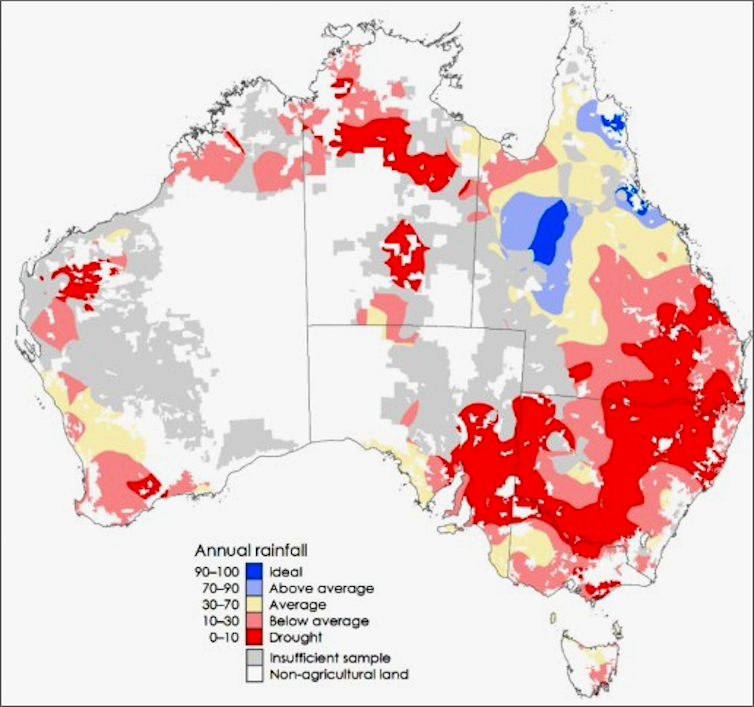
Model-based indicator:

Drought Declarations Are Mattering Less
Since the early 2000s, drought policy has evolved away from in-drought support of farm businesses to an approach that emphasises preparedness and resilience, making explicit drought “declarations” less common.
While this change has been welcome, it also led to a reduced focus on drought impact measurement (with the exception of some state-level systems).
But as recent droughts have shown, information on the extent and severity of drought impacts is still very important.
For one, it can help governments anticipate and prepare for increased demand for farm programs such as the Farm Household Allowance or the Rural Financial Counselling Service.
It can also help to better target resources for community, animal welfare or mental health drought impacts.
Better indicators can also support the development of new insurance products such as index-based weather insurance.
Such products are more likely to take off where indexes (and therefore payouts) can closely match real-world outcomes.
Early Warnings Are Mattering More
While there is some evidence climate change has exacerbated recent droughts in Australia, there remains much uncertainty over the longer term effects.
Regardless, the potential for more extreme weather events is generally increasing the importance of early warning systems.
ABARES is working with the CSIRO and the Bureau of Meteorology to develop a Drought Early Warning System that will use this new indicator and a range of other tools to translate weather data into estimates of likely farm impacts.
Predicting these impacts remains very difficult, with challenges both in weather forecasting (particularly on monthly or longer time scales), and in translating these forecasts into agricultural outcomes.
But any improvements we can make will help us better respond to what the future has in store.![]()
Neal Hughes, Adjunct Associate Professor, Centre for Regional and Rural Futures, Deakin University
This article is republished from The Conversation under a Creative Commons license. Read the original article.
The Soviet Union once hunted endangered whales to the brink of extinction – but its scientists opposed whaling and secretly tracked its toll

Every year, an estimated 13 million people go whale-watching around the world, marveling at the sight of the largest animals ever to inhabit Earth. It’s a dramatic reversal from a century ago, when few people ever saw a living whale. The creatures are still recovering from massive industrial-scale hunting that nearly wiped out several species in the 20th century.
The history of whaling shows how humans have wreaked careless havoc on the ocean, but also how they can change course. In my new book, “Red Leviathan: The Secret History of Soviet Whaling,” I describe how the Soviet Union was central both to this deadly industry and to scientific research that helps us understand whales’ recovery.
From Wood To Steel And Bad To Worse
At the start of the 20th century, it seemed whales might gain a reprieve after years of hunting. The era of whaling from sail boats, depicted in such memorable detail by Herman Melville in “Moby-Dick,” had nearly wiped out slow, fat species like right and bowhead whales, and also wreaked substantial harm to sperm whales.
In the 1800s, U.S. whalers sailed without restraint or hindrance into every corner of the world’s oceans, including waters around Russia’s Siberian empire. There, tsarist officials watched in helpless rage as Americans slaughtered whales upon which many of the region’s Indigenous peoples relied.
In the 1870s, petroleum began to replace whale oil as a fuel. With few catchable whales remaining, the industry appeared to be near its end. But whalers found new markets. Through hydrogenation – a chemical process that can be used to turn liquid oils into solid or semi-solid fats – manufacturers were able to transform smelly whale products into odorless margarine for human consumption.
Around the same time, Norwegians invented the explosive harpoon, which killed whales more efficiently than hand-thrown versions, and the stern slipway, which allowed whale carcasses to be processed on board ships. Along with diesel engines and steel hulls, these technologies enabled whalers to target previously untouched species in once-inaccesible locations, such as the Antarctic.

Late To The Party, Late To Leave
As mechanized whaling gained force in the 1920s and ‘30s, Norwegian, British and Japanese whalers cut through populations of blue, fin and humpback whales on a scale that is hard to believe today. In what scientists once thought was the peak catch year, 1937, over 63,000 large whales were killed and processed.
World War II briefly suspended this slaughter, which many governments were starting to realize threatened the survival of some whale species. In 1946, whalers, statesmen and scientists created the International Whaling Commission in hopes of heading off a return to disastrous prewar levels of whaling.
That same year, the USSR joined the IWC and took control over a former Nazi whaleship, which it renamed the Slava, or Glory. No one suspected the central role the country would play in the most disastrous two decades of whales’ long history on Earth.
The Madness Of Modern Whaling
Despite the IWC’s best intentions, postwar catches rose quickly. By the mid-1950s, even longtime whalers had to admit that big whales were becoming too scarce for their industries to be profitable. All nations except Japan began to ponder the end of whaling.
It thus came as a shock when the Soviet Union announced in 1956 that it planned to build seven new “floating factories” – gigantic industrial processing ships, accompanied by fleets of smaller “catcher” boats that would scour the oceans for whales.
Soviet whale scientists were as stunned as observers elsewhere. These biologists and oceanographers had been watching the decline from ships and from their labs in the Fisheries Ministry and Academy of Sciences since the 1930s.
Instead of supporting the fleet expansion, they argued forcefully that whales stood on the brink of extinction, and whaling should decrease radically, not expand. This was how the Soviet planned economy was meant to work: Science, not profit, would help guide economic decisions, letting planners know how much could be extracted from the natural world and when to stop.
But Soviet officials were determined to finally catch whales on a large scale, as Western nations had done for so long. The Fisheries Ministry ignored its scientists’ recommendations and built five of the seven planned floating factories over the next decade.
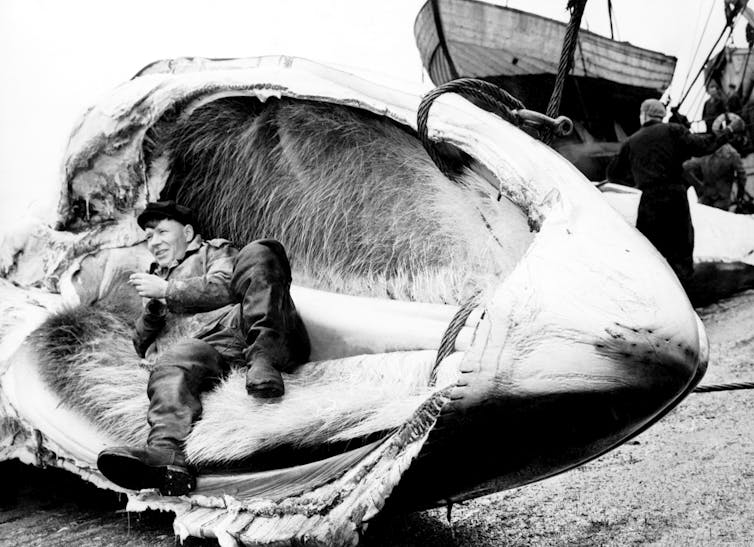
By the 1960s, the Soviet Union was the world’s largest whaling nation. Whalers such as the legendary captain Aleksei Solyanik were celebrated as superstars, comparable to astronauts like Yuri Gagarin.
But the scientists had been right: Many whales species were nearly gone. To produce large catches, Solyanik and other captains decided to ignore international quotas and secretly targeted the most endangered whale species, including blue, humpback and fin whales in the Antarctic and the North Pacific.
In 1961, for example, Soviet fleets killed 9,619 rare humpbacks south of New Zealand, while reporting only 302 to the IWC. This was only a portion of their global catch, which the Soviet Union continued to underreport for years. Driven by Moscow’s demands for ever-increasing production, whalers worked at reckless speed, wasting much of the fat and meat taken from the dead whales. It is doubtful the industry was ever profitable.
Thanks to Soviet scientists who preserved some records of these illegal kills and to subsequent work by other scholars, it now appears likely that the Soviet Union killed around 550,000 whales after World War II while reporting only 360,000. We now know that global whale harvesting peaked in 1964, not 1937, with a total of 91,783 whales killed – about 40% by Soviet whalers.
Not Quite Extinct
By the 1970s, populations of large whales had dwindled to insignificance. Many observers were sure extinction was inevitable. But momentum for whale conservation was growing.
The U.S. listed blue, fin, sei, sperm and humpback whales under the law that preceded the Endangered Species Act in 1970, then continued to protect them under that law, enacted in 1973. Whales also received protection in U.S. waters under the 1972 Marine Mammal Protection Act.
Thanks to pressure from environmentalists and its own citizens, the Soviet Union ended its whaling industry in 1987. The country accepted a global moratorium on commercial whaling, which remains in force today with only three holdouts: Norway, Iceland and Japan.
Whale numbers almost immediately began to rebound. Humpback whales were especially successful, but populations of bowhead, fin and sperm whales also expanded in the near absence of commercial whaling. However, some species, notably North Atlantic right whales, remain endangered or critically endangered.
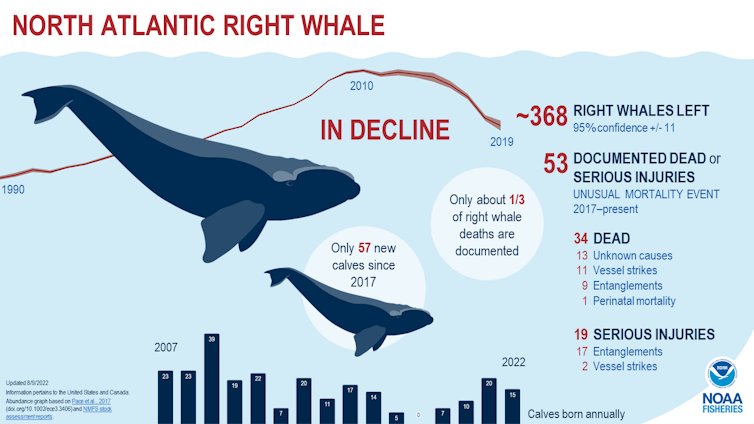
In one of the greatest conservation successes, Eastern Pacific gray whales are today estimated to have returned to pre-exploitation abundance, and may actually be reaching the limits of what their primary foraging grounds in the Bering Sea can support. And in 2018 and 2019, German scientists and researchers from the BBC observed and filmed fin whales feeding around the Antarctic peninsula in vast pods that recalled the way the ocean must have looked before the 20th century.
Thanks to the Russian scientists who opposed their country’s disastrous whaling expansion and kept its records, we know how many whales were lost in the 20th century. That information can also help scientists, governments and conservationists judge whales’ remarkable but far from complete recovery.![]()
Ryan Jones, Associate Professor of History, University of Oregon
This article is republished from The Conversation under a Creative Commons license. Read the original article.
Influential oil company scenarios for combating climate change don’t actually meet the Paris Agreement goals, our new analysis shows

Several major oil companies, including BP and Shell, periodically publish scenarios forecasting the future of the energy sector. In recent years, they have added visions for how climate change might be addressed, including scenarios that they claim are consistent with the international Paris climate agreement.
These scenarios are hugely influential. They are used by companies making investment decisions and, importantly, by policymakers as a basis for their decisions.
But are they really compatible with the Paris Agreement?
Many of the future scenarios show continued reliance on fossil fuels. But data gaps and a lack of transparency can make it difficult to compare them with independent scientific assessments, such as the global reviews by the Intergovernmental Panel on Climate Change.
In a study published Aug. 16, 2022, in Nature Communications, our international team analyzed four of these scenarios and two others by the International Energy Agency using a new method we developed for comparing such energy scenarios head-to-head. We determined that five of them – including frequently cited scenarios from BP, Shell and Equinor – were not consistent with the Paris goals.
What The Paris Agreement Expects
The 2015 Paris Agreement, signed by nearly all countries, sets out a few criteria to meet its objectives.
One is to ensure the global average temperature increase stays well below 2 degrees Celsius (3.6 F) compared to pre-industrial era levels, and to pursue efforts to keep warming under 1.5°C (2.7 F). The agreement also states that global emissions should peak as soon as possible and reach at least net zero greenhouse gas emissions in the second half of the century. Pathways that meet these objectives show that carbon dioxide emissions should fall even faster, reaching net zero by about 2050.
Scientific evidence shows that overshooting 1.5°C of warming, even temporarily, would have harmful consequences for the global climate. Those consequences are not necessarily reversible, and it’s unclear how well people, ecosystems and economies would be able to adapt.
How The Scenarios Perform
We have been working with the nonprofit science and policy research institute Climate Analytics to better understand the implications of the Paris Agreement for global and national decarbonization pathways – the paths countries can take to cut their greenhouse gas emissions. In particular, we have explored the roles that coal and natural gas can play as the world transitions away from fossil fuels.
When we analyzed the energy companies’ decarbonization scenarios, we found that BP’s, Shell’s and Equinor’s scenarios overshoot the 1.5°C limit of the Paris Agreement by a significant margin, with only BP’s having a greater than 50% chance of subsequently drawing temperatures down to 1.5°C by 2100.
These scenarios also showed higher near-term use of coal and long-term use of gas for electricity production than Paris-compatible scenarios, such as those assessed by the IPCC. Overall, the energy company scenarios also feature higher levels of carbon dioxide emissions than Paris-compatible scenarios.
Of the six scenarios, we determined that only the International Energy Agency’s Net Zero by 2050 scenario sketches out an energy future that is compatible with the 1.5°C Paris Agreement goal.
We found this scenario has a greater than 33% chance of keeping warming from ever exceeding 1.5°C, a 50% chance of having temperatures 1.5°C warmer or less in 2100, and a nearly 90% chance of keeping warming always below 2°C. This is in line with the criteria we use to assess Paris Agreement consistency, and also in line with the approach taken in the IPCC’s Special Report on 1.5°C, which highlights pathways with no or limited overshoot to be 1.5°C compatible.
Getting The Right Picture Of Decarbonization
When any group publishes future energy scenarios, it’s useful to have a transparent way to make an apples-to-apples comparison and evaluate the temperature implications. Most of the corporate scenarios, with the exception of Shell’s Sky 1.5 scenario, don’t extend beyond midcentury and focus on carbon dioxide without assessing other greenhouse gases.
Our method uses a transparent procedure to extend each pathway to 2100 and estimate emissions of other gases, which allows us to calculate the temperature outcomes of these scenarios using simple climate models.
Without a consistent basis for comparison, there is a risk that policymakers and businesses will have an inaccurate picture about the pathways available for decarbonizing economies.
Meeting the 1.5°C goal will be challenging. The planet has already warmed about 1.1°C since pre-industrial times, and people are suffering through deadly heat waves, droughts, wildfires and extreme storms linked to climate change. There is little room for false starts and dead-ends as countries transform their energy, agricultural and industrial systems on the way to net-zero greenhouse gas emissions.![]()
Robert Brecha, Professor of Sustainability, University of Dayton and Gaurav Ganti, Ph.D. Student in Geography, Humboldt University of Berlin
This article is republished from The Conversation under a Creative Commons license. Read the original article.
Pittwater Reserves: Histories + Notes + Pictorial Walks
A History Of The Campaign For Preservation Of The Warriewood Escarpment by David Palmer OAM and Angus Gordon OAM
America Bay Track Walk - photos by Joe Mills
An Aquatic June: North Narrabeen - Turimetta - Collaroy photos by Joe Mills
Angophora Reserve Angophora Reserve Flowers Grand Old Tree Of Angophora Reserve Falls Back To The Earth - History page
Annie Wyatt Reserve - A Pictorial
Avalon's Village Green: Avalon Park Becomes Dunbar Park - Some History + Toongari Reserve and Catalpa Reserve
Bairne Walking Track Ku-Ring-Gai Chase NP by Kevin Murray
Bangalley Headland Bangalley Mid Winter
Banksias of Pittwater
Barrenjoey Boathouse In Governor Phillip Park Part Of Our Community For 75 Years: Photos From The Collection Of Russell Walton, Son Of Victor Walton
Barrenjoey Headland: Spring flowers
Barrenjoey Headland after fire
Bayview Baths
Bayview Wetlands
Beeby Park
Bilgola Beach
Botham Beach by Barbara Davies
Bungan Beach Bush Care
Careel Bay Saltmarsh plants
Careel Bay Birds
Careel Bay Clean Up day
Careel Bay Playing Fields History and Current
Careel Creek
Careel Creek - If you rebuild it they will come
Centre trail in Ku-ring-gai Chase National Park
Chiltern Track- Ingleside by Marita Macrae
Clareville Beach
Clareville/Long Beach Reserve + some History
Coastal Stability Series: Cabbage Tree Bay To Barrenjoey To Observation Point by John Illingsworth, Pittwater Pathways, and Dr. Peter Mitchell OAM
Cowan Track by Kevin Murray
Curl Curl To Freshwater Walk: October 2021 by Kevin Murray and Joe Mills
Currawong and Palm Beach Views - Winter 2018
Currawong-Mackerel-The Basin A Stroll In Early November 2021 - photos by Selena Griffith
Currawong State Park Currawong Beach + Currawong Creek
Deep Creek To Warriewood Walk photos by Joe Mills
Drone Gives A New View On Coastal Stability; Bungan: Bungan Headland To Newport Beach + Bilgola: North Newport Beach To Avalon + Bangalley: Avalon Headland To Palm Beach
Duck Holes: McCarrs Creek by Joe Mills
Dunbar Park - Some History + Toongari Reserve and Catalpa Reserve
Dundundra Falls Reserve: August 2020 photos by Selena Griffith - Listed in 1935
Elsie Track, Scotland Island
Elvina Track in Late Winter 2019 by Penny Gleen
Elvina Bay Walking Track: Spring 2020 photos by Joe Mills
Elvina Bay-Lovett Bay Loop Spring 2020 by Kevin Murray and Joe Mills
Fern Creek - Ingleside Escarpment To Warriewood Walk + Some History photos by Joe Mills
Iluka Park, Woorak Park, Pittwater Park, Sand Point Reserve, Snapperman Beach Reserve - Palm Beach: Some History
Ingleside
Ingleside Wildflowers August 2013
Irrawong - Ingleside Escarpment Trail Walk Spring 2020 photos by Joe Mills
Irrawong - Mullet Creek Restoration
Katandra Bushland Sanctuary - Ingleside
Lucinda Park, Palm Beach: Some History + 2022 Pictures
McCarrs Creek
McCarr's Creek to Church Point to Bayview Waterfront Path
McKay Reserve
Mona Vale Beach - A Stroll Along, Spring 2021 by Kevin Murray
Mona Vale Headland, Basin and Beach Restoration
Mount Murray Anderson Walking Track by Kevin Murray and Joe Mills
Mullet Creek
Narrabeen Creek
Narrabeen Lagoon Catchment: Past Notes Present Photos by Margaret Woods
Narrabeen Lagoon State Park
Narrabeen Lagoon State Park Expansion
Narrabeen Rockshelf Aquatic Reserve
Nerang Track, Terrey Hills by Bea Pierce
Newport Bushlink - the Crown of the Hill Linked Reserves
Newport Community Garden - Woolcott Reserve
Newport to Bilgola Bushlink 'From The Crown To The Sea' Paths: Founded In 1956 - A Tip and Quarry Becomes Green Space For People and Wildlife
Pittwater spring: waterbirds return to Wetlands
Pittwater's Lone Rangers - 120 Years of Ku-Ring-Gai Chase and the Men of Flowers Inspired by Eccleston Du Faur
Pittwater's Parallel Estuary - The Cowan 'Creek
Resolute Track at West Head by Kevin Murray
Resolute Track Stroll by Joe Mills
Riddle Reserve, Bayview
Salvation Loop Trail, Ku-Ring-Gai Chase National Park- Spring 2020 - by Selena Griffith
Seagull Pair At Turimetta Beach: Spring Is In The Air!
Stapleton Reserve
Stapleton Park Reserve In Spring 2020: An Urban Ark Of Plants Found Nowhere Else
The Chiltern Track
The Resolute Beach Loop Track At West Head In Ku-Ring-Gai Chase National Park by Kevin Murray
Topham Track Ku-Ring-Gai Chase NP, August 2022 by Joe Mills and Kevin Murray
Towlers Bay Walking Track by Joe Mills
Trafalgar Square, Newport: A 'Commons' Park Dedicated By Private Landholders - The Green Heart Of This Community
Tranquil Turimetta Beach, April 2022 by Joe Mills
Turimetta Beach Reserve by Joe Mills, Bea Pierce and Lesley
Turimetta Beach Reserve: Old & New Images (by Kevin Murray) + Some History
Turimetta Headland
Warriewood Wetlands and Irrawong Reserve
Whale Beach Ocean Reserve: 'The Strand' - Some History On Another Great Protected Pittwater Reserve
Wilshire Park Palm Beach: Some History + Photos From May 2022
Winji Jimmi - Water Maze

New Shorebirds WingThing For Youngsters Available To Download
A Shorebirds WingThing educational brochure for kids (A5) helps children learn about shorebirds, their life and journey. The 2021 revised brochure version was published in February 2021 and is available now. You can download a file copy here.
If you would like a free print copy of this brochure, please send a self-addressed envelope with A$1.10 postage (or larger if you would like it unfolded) affixed to: BirdLife Australia, Shorebird WingThing Request, 2-05Shorebird WingThing/60 Leicester St, Carlton VIC 3053.

 Shorebird Identification Booklet
Shorebird Identification Booklet
The Migratory Shorebird Program has just released the third edition of its hugely popular Shorebird Identification Booklet. The team has thoroughly revised and updated this pocket-sized companion for all shorebird counters and interested birders, with lots of useful information on our most common shorebirds, key identification features, sighting distribution maps and short articles on some of BirdLife’s shorebird activities.
The booklet can be downloaded here in PDF file format: http://www.birdlife.org.au/documents/Shorebird_ID_Booklet_V3.pdf
Paper copies can be ordered as well, see http://www.birdlife.org.au/projects/shorebirds-2020/counter-resources for details.
Download BirdLife Australia's children’s education kit to help them learn more about our wading birdlife
Shorebirds are a group of wading birds that can be found feeding on swamps, tidal mudflats, estuaries, beaches and open country. For many people, shorebirds are just those brown birds feeding a long way out on the mud but they are actually a remarkably diverse collection of birds including stilts, sandpipers, snipe, curlews, godwits, plovers and oystercatchers. Each species is superbly adapted to suit its preferred habitat. The Red-necked Stint is as small as a sparrow, with relatively short legs and bill that it pecks food from the surface of the mud with, whereas the Eastern Curlew is over two feet long with a exceptionally long legs and a massively curved beak that it thrusts deep down into the mud to pull out crabs, worms and other creatures hidden below the surface.
Some shorebirds are fairly drab in plumage, especially when they are visiting Australia in their non-breeding season, but when they migrate to their Arctic nesting grounds, they develop a vibrant flush of bright colours to attract a mate. We have 37 types of shorebirds that annually migrate to Australia on some of the most lengthy and arduous journeys in the animal kingdom, but there are also 18 shorebirds that call Australia home all year round.
What all our shorebirds have in common—be they large or small, seasoned traveller or homebody, brightly coloured or in muted tones—is that each species needs adequate safe areas where they can successfully feed and breed.
The National Shorebird Monitoring Program is managed and supported by BirdLife Australia.
This project is supported by Glenelg Hopkins Catchment Management Authority and Hunter Local Land Services through funding from the Australian Government’s National Landcare Program. Funding from Helen Macpherson Smith Trust and Port Phillip Bay Fund is acknowledged.
The National Shorebird Monitoring Program is made possible with the help of over 1,600 volunteers working in coastal and inland habitats all over Australia.
The National Shorebird Monitoring program (started as the Shorebirds 2020 project initiated to re-invigorate monitoring around Australia) is raising awareness of how incredible shorebirds are, and actively engaging the community to participate in gathering information needed to conserve shorebirds.
In the short term, the destruction of tidal ecosystems will need to be stopped, and our program is designed to strengthen the case for protecting these important habitats.
In the long term, there will be a need to mitigate against the likely effects of climate change on a species that travels across the entire range of latitudes where impacts are likely.
The identification and protection of critical areas for shorebirds will need to continue in order to guard against the potential threats associated with habitats in close proximity to nearly half the human population.
Here in Australia, the place where these birds grow up and spend most of their lives, continued monitoring is necessary to inform the best management practice to maintain shorebird populations.
BirdLife Australia believe that we can help secure a brighter future for these remarkable birds by educating stakeholders, gathering information on how and why shorebird populations are changing, and working to grow the community of people who care about shorebirds.
To find out more visit: http://www.birdlife.org.au/projects/shorebirds-2020/shorebirds-2020-program
Aussie Bread Tags Collection Points

Cuttlefish
When you're having a walk on the beach you may sometimes find one of these - we saw this one on Whale Beach:

Do you know what is it?
That's right - it's a cuttlefish bone. You may have seen these in pet shops too as they are good for pet birds. For birds Cuttlefish bone serves as a source of calcium, which is lacking in seed. It also provides your bird with a hard surface to gnaw on, which should help to prevent their bill from becoming overgrown.
But what is a cuttlefish?
Cuttlefish or cuttles are marine molluscs of the order Sepiida. They belong to the class Cephalopoda which also includes squid, octopuses, and nautiluses. Cuttlefish have a unique internal shell, the cuttlebone, which is used for control of buoyancy.
Cuttlefish have large, W-shaped pupils, eight arms, and two tentacles furnished with denticulated suckers, with which they secure their prey. They generally range in size from 15 to 25 cm (6 to 10 in), with the largest species, the giant cuttlefish (Sepia apama), reaching 50 cm (20 in) in mantle length and over 10.5 kg (23 lb) in mass.
Cuttlefish eat small molluscs, crabs, shrimp, fish, octopus, worms, and other cuttlefish. Their predators include dolphins, sharks, fish, seals, seabirds, and other cuttlefish. The typical life expectancy of a cuttlefish is about 1–2 years. Studies are said to indicate cuttlefish to be among the most intelligent invertebrates. Cuttlefish also have one of the largest brain-to-body size ratios of all invertebrates.
The "cuttle" in cuttlefish comes from the Old English name for the species, cudele, which may be cognate with the Old Norse koddi (cushion) and the Middle Low German Kudel (rag). The Greco-Roman world valued the cuttlefish as a source of the unique brown pigment the creature releases from its siphon when it is alarmed. The word for it in both Greek and Latin, sepia, now refers to the reddish-brown colour sepia in English.
.jpg?timestamp=1660937587341)
Sepia mestus swimming (Australia). Photo: John Turnbull
The earliest fossils of cuttlefish are from the Cretaceous period, so 145 million to 66 million years ago.
The family Sepiidae, which contains all cuttlefish, inhabits tropical and temperate ocean waters. They are mostly shallow-water animals, although they are known to go to depths of about 600 m (2,000 ft).[10] They have an unusual biogeographic pattern; they are present along the coasts of East and South Asia, Western Europe, and the Mediterranean, as well as all coasts of Africa and Australia, but are totally absent from the Americas. By the time the family evolved, ostensibly in the Old World, the North Atlantic possibly had become too cold and deep for these warm-water species to cross.
Cuttlefish, like other cephalopods, have sophisticated eyes. The organogenesis and the final structure of the cephalopod eye fundamentally differ from those of vertebrates such as humans. Superficial similarities between cephalopod and vertebrate eyes are thought to be examples of convergent evolution. The cuttlefish pupil is a smoothly curving W-shape. Although cuttlefish cannot see colour, they can perceive the polarization of light, which enhances their perception of contrast. They have two spots of concentrated sensor cells on their retinas (known as foveae), one to look more forward, and one to look more backward. The eye changes focus by shifting the position of the entire lens with respect to the retina, instead of reshaping the lens as in mammals. Unlike the vertebrate eye, no blind spot exists, because the optic nerve is positioned behind the retina. They are capable of using stereopsis, enabling them to discern depth/distance because their brain calculates the input from both eyes.
The cuttlefish's eyes are thought to be fully developed before birth, and they start observing their surroundings while still in the egg. In consequence, they may prefer to hunt the prey they saw before hatching.
Cuttlefish possess an internal structure called the cuttlebone, which is porous and is made of aragonite. The pores provide it with buoyancy, which the cuttlefish regulates by changing the gas-to-liquid ratio in the chambered cuttlebone via the ventral siphuncle. Each species' cuttlebone has a distinct shape, size, and pattern of ridges or texture. The cuttlebone is unique to cuttlefish, and is one of the features that distinguish them from their squid relatives.
As can be read above, cuttlefish are relatives to octopus.
A few weeks back Joe Mills, who send in great photos each week to share with you, sent in some images of an octopus at North Narrabeen. Joe says;
''The octopus is back again. This little one is hard to spot with great camouflage. The grey material is scooped soil to make space under the rock. I think the occy is a small female.''
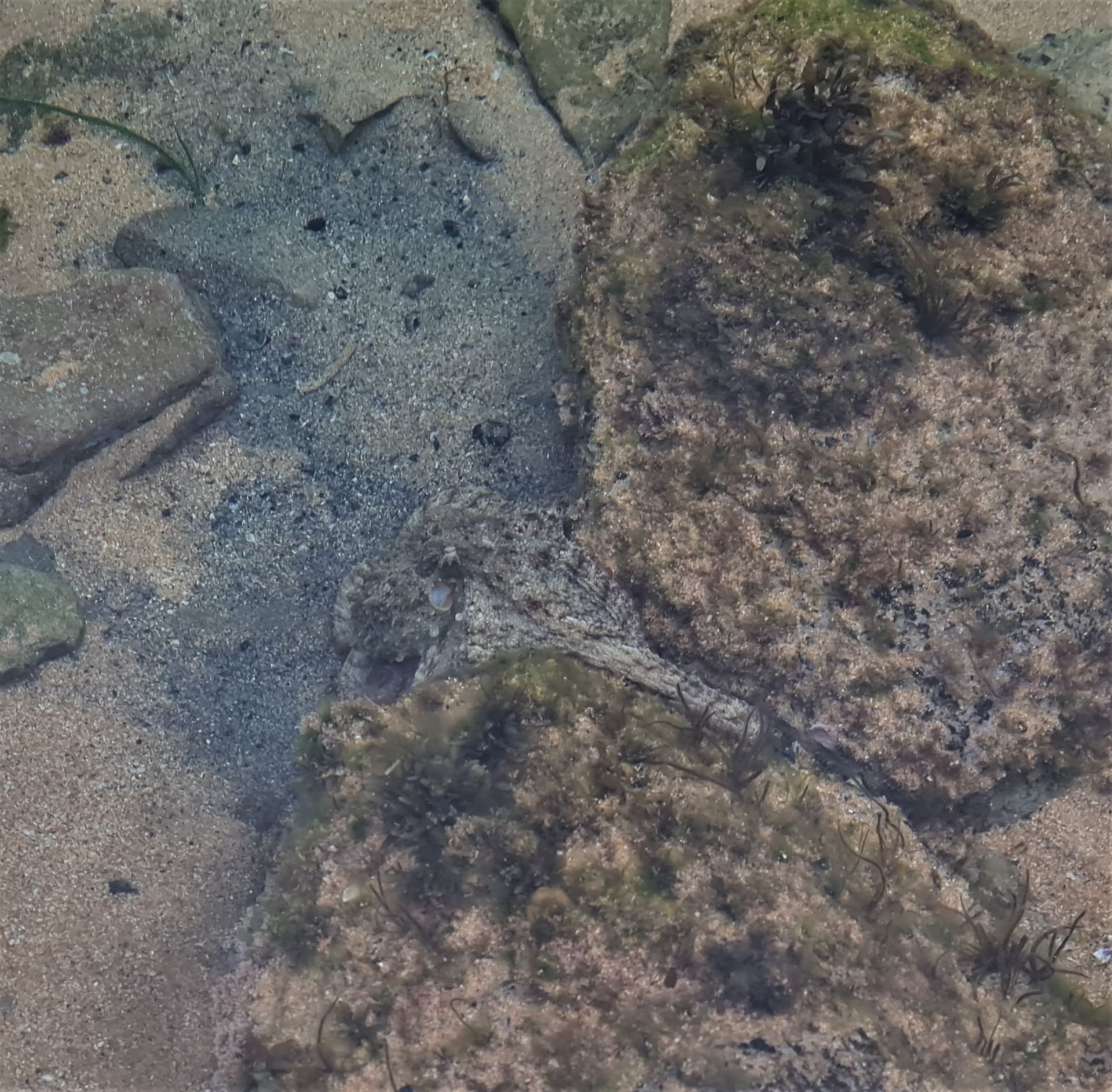
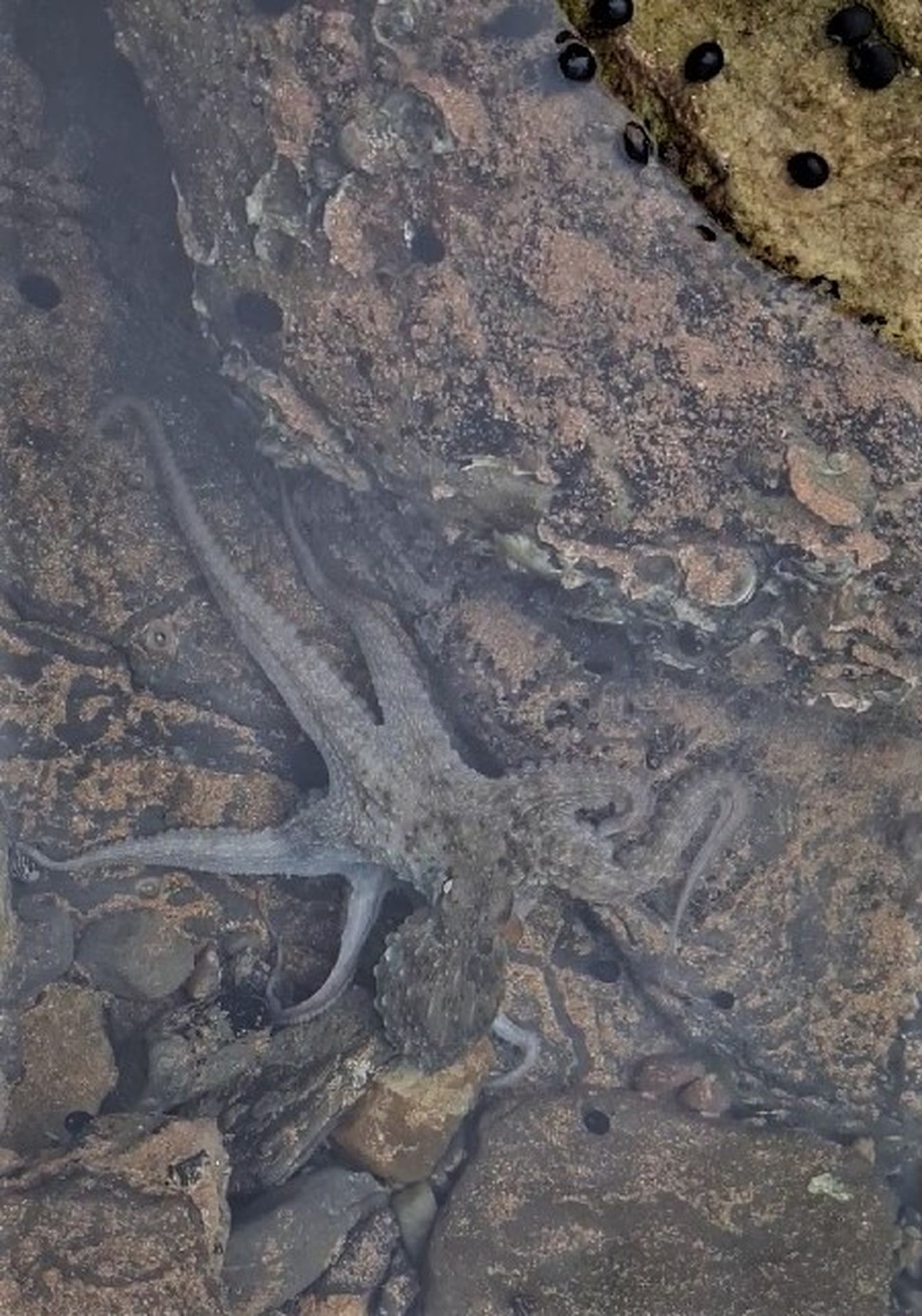
How To Win When You Don't : Lea Davison
Be The Boss: I Want To Be A Pilot
If you love travelling, or the sensation of freedom that comes with being up in the blue sky, or fiddling with knobs and dials, a career as a pilot may be for you.
Pilots are trained to operate aircraft, including airplanes and helicopters, in order to transport passengers and goods between locations. Flying aircraft includes takeoff and landing, staying in touch with the control tower on departure, and requesting permission to land on approach to destinations.
A commercial airline pilot is usually assisted by a Co-pilot, but in smaller aircraft, the Pilot must navigate in addition to monitoring engines, fuel, and aircraft systems throughout the flight.
Pilots also file flight plans, perform maintenance checks and ensure the craft is ready for departure.
To become a Pilot you need a licence, which requires many hours of practical and theoretical training. Specific training requirements vary depending on the type of licence you want.
Complete high school. While a high school certificate isn’t always a formal requirement, secondary education will teach you math and English skills that are important for Pilot roles.
Choose the licence type you want to pursue and a flight school that aligns with your goals. Two common licence types are Private Pilot Licences (PPL) and Commercial Pilot Licences (CPL).
Hold a current medical certificate. There are different types of medical certificates required depending on the licence you’re pursuing.
Complete the training required for your chosen licence type. A PPL usually involves 55–60 hours of flight training over 2–12 months. A CPL usually requires at least 150 hours of flight training over 12 months.
Pass an exam and flight test to earn your licence and fly solo.
While most people think of pilots flying passengers around the world
on commercial airlines, there are many more diverse career paths in
aviation. Some of these are:
- › instructing people to become pilots or learn new skills
- › charter flying to carry people for business or tourism
- › agricultural flying
- › aerial photography and survey work
- › helicopter mustering
- › military flying in some of the world’s most expensive and advanced aircraft.
Aviation is also critical in medical evacuations, firefighting and other emergency operations to help save people’s lives, livelihoods, and homes.
Professional pilots must be able to physically control an aircraft, as well as make accurate decisions in complex, time-critical situations.
You will need to be in good health, have good eyesight and hearing, and typically have an education in English to become a commercial pilot. Most people who succeed in aviation have above-average initiative, self-discipline, common sense, patience and perseverance.
This guide will help you decide if flying is a good career for you. You should also do as much research as possible. Contact or visit flight training organisations and talk to people in the industry.
The amount of training required can seem daunting at first, but with drive and dedication, you can turn your love of flying into a highly satisfying career.
Download (PDF) PILOT CAREER GUIDE 2021 by CASA (Civil Aviation Safety Authority - Australian Government).
The Civil Aviation Safety Authority (CASA) does not require you to have any formal educational qualifications to train for an Australian pilot licence.
You can pass CASA’s private pilot licence examination with a standard education and ability to speak, read, write and understand the English language.
For commercial or higher licence levels, a good background in maths and physics is useful, but not essential. If you don’t have this background, you could consider theory training with a reputable theory training centre or theory provider.
It is also a good idea to contact employers in your area of aviation interest to check their requirements. Many airlines generally require passes at high school certificate level in physics and maths, although this may vary between companies. Some may suggest you investigate aviation diplomas or degrees offered by some universities.
Information courtesy Australian Government Apprenticeships Guide (Your Career), Australian Open Colleges, Australian Careers HQ and The Good Universities Guide, Australia.

U.S. Army Air Forces test pilot Lt. F.W. "Mike" Hunter wearing a flight suit in October 1942. Photo by Alfred T. Palmer
Also Available
Nullarbor
Fee-Free Training To Supercharge NSW's Early Learning Workforce
Art Competition To Remember Our ANZACS
Word Of The Week: Warriewood
From the middle family name of the Macpherson family who owned much of the land in Warriewood.
.jpg?timestamp=1537905699975)
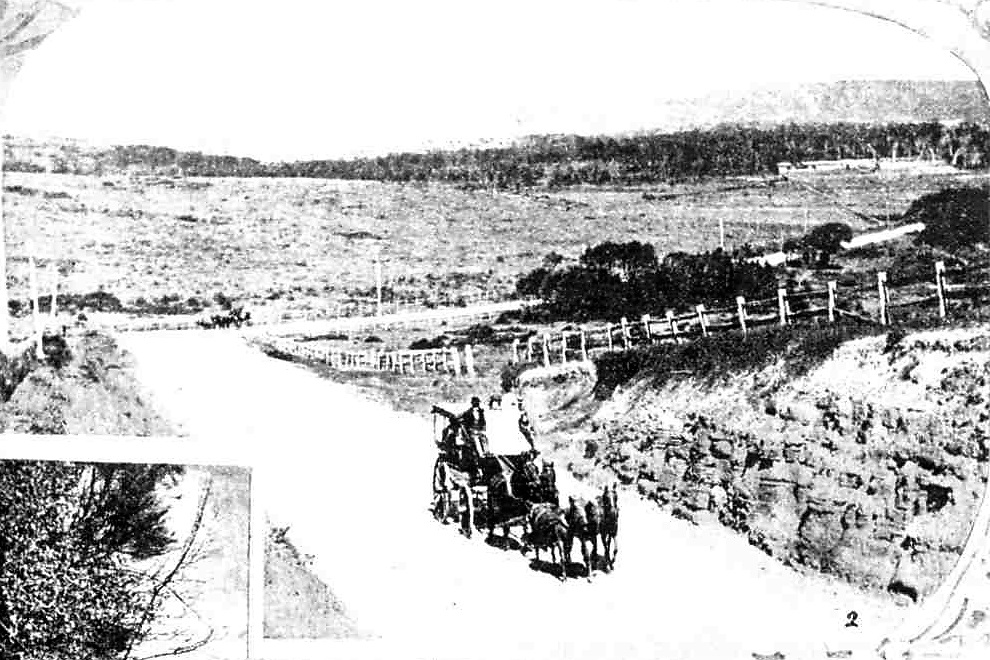
1. On the Narrabeen Lagoon. 2. View from Sheepstation Hill, looking south. 3. Bay View. 4. A dip in the surf at Narrabeen. 5. Near Long Reef. 6. Approaching Narrabeen. 7. One of the creeks. The distance from Manly to Bay View is about 15 miles. The road is by the Narrabeen-road past Rocklily. A proposal to put down a tram line is now being considered, and a member of the ministry was recently driven over the country, which in many parts is remarkably picturesque. MANLY TO BAY VIEW—A POPULAR EASTER RESORT BY ROAD. (1900, April 14). The Sydney Mail and New South Wales Advertiser (NSW : 1871 - 1912), p. 878. Retrieved from http://nla.gov.au/nla.news-article165297416
Warriewood at this time was still very wooded - although men such as Leon Houreux, of the Rock Lily, was one of the woodcutters who may have worked for fellow Frenchman Gustave Lix who owned the land housing the failed Ingleside Powder Works are stated to have been woodcutters in the valley, even as late as the 1950's and 1960's the valley and its hill surrounds were still very alike the hills above and part of the Narrabeen Lagoon State Park we see today.
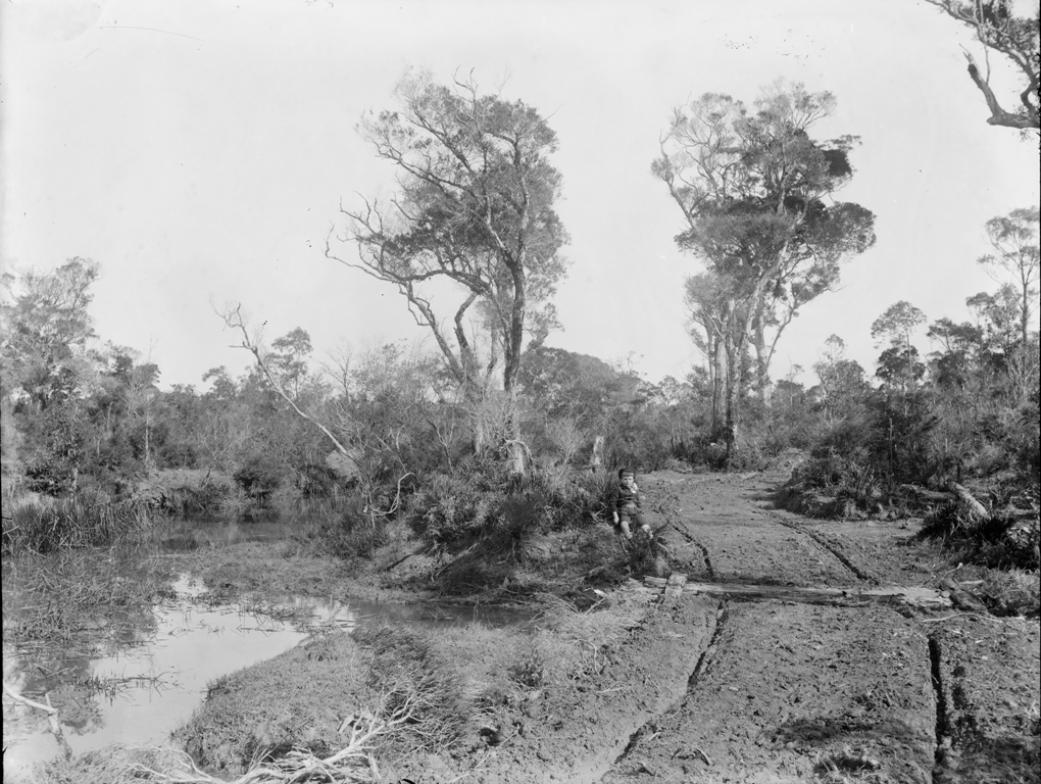
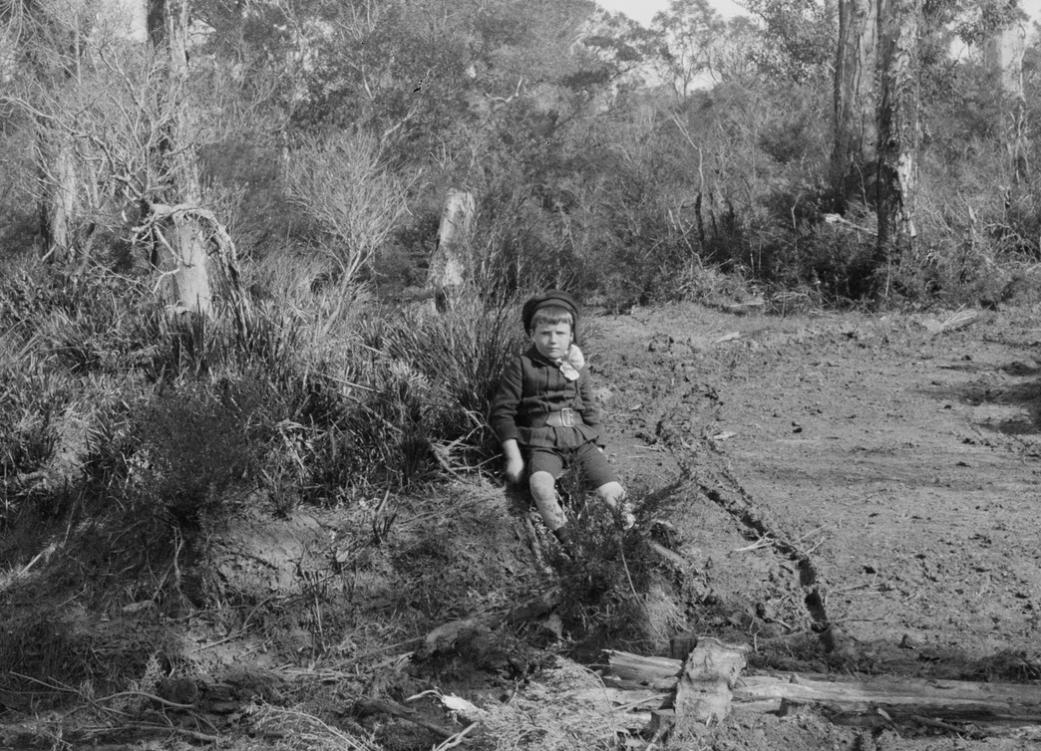
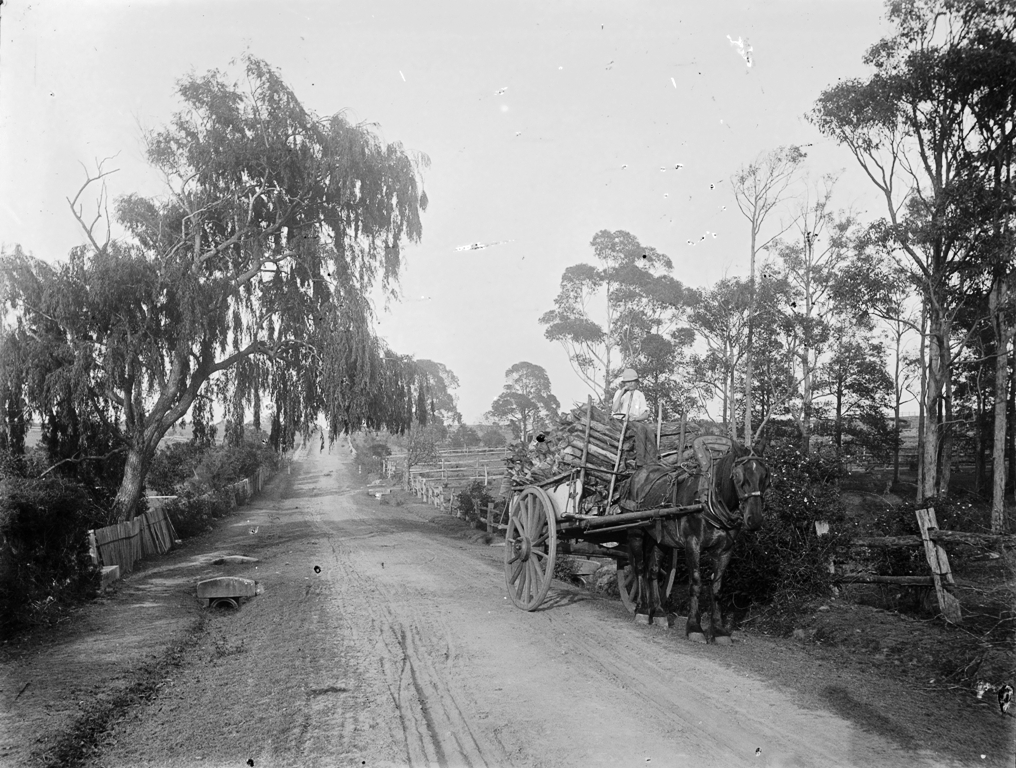
At Last - Etta James
Nina Simone - Feeling Good
Joan Armatrading-Drop The Pilot
Alicia Keys - Empire State Of Mind (New York)
Is fake meat healthy? And what’s actually in it?

The popularity of plant-based proteins, or “fake meat”, has increased in recent years as consumers look to eat fewer animal products. In fact, plant-based protein is projected to be a A$3 billion opportunity for Australia by 2030.
Many consumers believe these fake meats are better for their health, as well as better for the environment, but is that right?
What Is Fake Meat?
It may sound obvious, but the first thing to say is that fake meat is not meat. Referring to these products as meat has been widely criticised by the meat industry, resulting in a recent Senate Committee report recommending mandatory regulation for the labelling of plant-based products.
Fake meats fall into two categories: plant-based proteins and cell-based proteins.
The plant-based burgers and sausages found on supermarket shelves are made by extracting the protein from plant foods, often pea, soy, wheat protein, and mushrooms.
But a myriad of additives are needed to make these products look and taste like traditional meat.
For example, chemically refined coconut oil and palm oil are often added to plant-based burgers to help mimic meat’s soft and juicy texture. Colouring agents, such as beetroot extracts, have been used in Beyond Meat’s “raw” burger to mimic the colour change that occurs when meat is cooked. And the additive soy leghemoglobin, produced by genetically engineered yeast, has been used to create the Impossible Foods “bleeding” burger.
Something not yet available on supermarket shelves in Australia is cell-based or “cultured” meat. This fake meat is made from an animal cell that is then grown in a lab culture to create a piece of meat. While it may sound like a far-off concept, Australia already has two cell-based meat producers.

Is Fake Meat Healthier?
Not necessarily.
In good news, an audit of over 130 products available in Australian supermarkets found plant-based products were, on average, lower in calories and saturated fat, and higher in carbohydrates and fibre than meat products.
But, not all plant-based products are created equal.
In fact, there are considerable differences in the nutrition content between products. For example, the saturated fat content of plant-based burgers in this audit ranged from 0.2 to 8.5 grams per 100 grams, meaning some plant-based products actually contained more saturated fat than a beef patty.
Salt levels in plant-based products are high, but vary between products. Plant-based mince can contain up to six times more sodium than meat equivalent products, whereas plant-based sausages contain two thirds less sodium on average.
The question then is, does swapping animal-based foods for plant-based foods improve health?
An eight week trial of 36 US adults investigated this, and researchers found switching to eating more plant-based products (while keeping all other foods and drinks as similar as possible) improved risk factors for heart disease, including cholesterol levels and body weight. However, research in this area is still in its infancy, and longer term trials are needed.
The bottom line is most fake meats are classified as ultra-processed foods.
They have undergone extensive industrial processing and include substances of “no or rare culinary use”, which means you would not find them in your average kitchen cupboard.
There is an opportunity for government and the food industry to ensure these highly processed plant-based products are re-formulated to contain less saturated fat and sodium, and to minimise the use of chemically derived additives.

Is Fake Meat Better For The Environment?
Yes, it can be.
The US Beyond Meat burger claims to use 99% less water, 93% less land and produce 90% fewer greenhouse gas emissions than a traditional beef patty.
Yet, the environmental footprint of plant-based products is a contentious topic, especially since ultra-processed foods have been widely criticised as being environmentally unsustainable.
A study published this month in The Lancet Planetary Health looked at the ethical and economic implications of eating more plant-based products. Researchers concluded switching from beef to plant-based products would reduce the carbon footprint of US food production by 2.5–13.5%, by reducing the number of animals needed for beef production by 2–12 million.
However, researchers noted any benefits to the agricultural workforce and natural resources were less clear.
So, Should We Be Eating Fake Meat?
Fake meats can be enjoyed as part of a healthy diet as a “sometimes food”.
When choosing plant-based products, check the label to choose lower salt and higher fibre options.
If you are looking for an alternative to meat that is both healthy for you and the environment, then whole plant foods are by far the best option for a plant-based or flexitarian diet.
Fresh or canned legumes, beans and chickpeas can be used to make your own meat-free burgers, and herbs and spices can add flavour to tofu.
Eating these whole plant foods also aligns with the Australian Guide to Healthy Eating, that recommends choosing lean meats and poultry, fish, eggs, tofu, nuts and seeds, and legumes/beans, and eating fewer processed meats such as salami, bacon, and sausages.![]()
Katherine Livingstone, NHMRC Emerging Leadership Fellow and Senior Research Fellow at the Institute for Physical Activity and Nutrition, Deakin University and Laura Marchese, PhD Student at the Institute for Physical Activity and Nutrition, Deakin University
This article is republished from The Conversation under a Creative Commons license. Read the original article.
Old age isn’t a modern phenomenon – many people lived long enough to grow old in the olden days, too

Every year I ask the college students in the course I teach about the 14th-century Black Death to imagine they are farmers or nuns or nobles in the Middle Ages. What would their lives have been like in the face of this terrifying disease that killed millions of people in just a few years?
Setting aside how they envision what it would be like to confront the plague, these undergrads often figure that during the medieval period they would already be considered middle-aged or elderly at the age of 20. Rather than being in the prime of life, they think they’d soon be decrepit and dead.
They’re reflecting a common misperception that long life spans in humans are very recent, and that no one in the past lived much beyond their 30s.
But that’s just not true. I am a bioarchaeologist, which means that I study human skeletons excavated from archaeological sites to understand what life was like in the past. I’m especially interested in demography – mortality (deaths), fertility (births) and migration – and how it was linked with health conditions and diseases such as the Black Death hundreds or thousands of years ago. There’s physical evidence that plenty of people in the past lived long lives – just as long as some people do today.
Bones Record The Length Of A Life
One of the first steps in research about demography in the past is to estimate how old people were when they died. Bioarchaeologists do this using information about how your bones and teeth change as you get older.
For example, I look for changes to joints in the pelvis that are common at older ages. Observations of these joints in people today whose ages we know allow us to estimate ages for people from archaeological sites with joints that look similar.
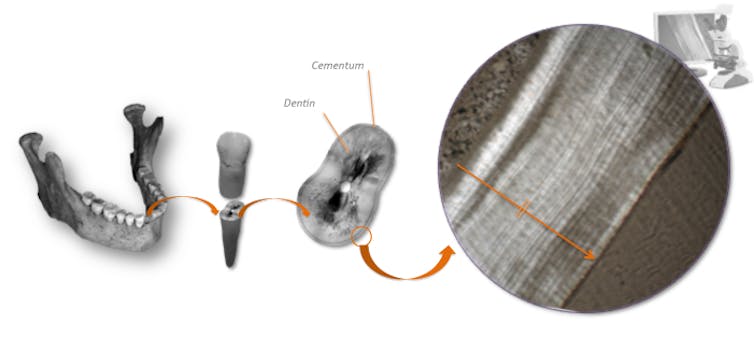
Another way to estimate age is to use a microscope to count the yearly additions of a mineralized tissue called cementum on teeth. It’s similar to counting a tree’s rings to see how many years it lived. Using approaches like these, many studies have documented the existence of people who lived long lives in the past.
For example, by examining skeletal remains, anthropologist Meggan Bullock and colleagues found that in the city of Cholula, Mexico, between 900 and 1531, most people who made it to adulthood lived past the age of 50.
And of course there are many examples from historical records of people who lived very long lives in the past. For example, the sixth-century Roman Emperor Justinian I reportedly died at the age of 83.
Analysis of the tooth development of an ancient anatomically modern Homo sapiens individual from Morocco suggests that our species has experienced long life spans for at least the past 160,000 years.
Clearing Up A Math Misunderstanding
Given physical and historical evidence that many people did live long lives in the past, why does the misperception that everyone was dead by the age of 30 or 40 persist? It stems from confusion about the difference between individual life spans and life expectancy.
Life expectancy is the average number of years of life remaining for people of a particular age. For example, life expectancy at birth (age 0) is the average length of life for newborns. Life expectancy at age 25 is how much longer people live on average given they’ve survived to age 25.
In medieval England, life expectancy at birth for boys born to families that owned land was a mere 31.3 years. However, life expectancy at age 25 for landowners in medieval England was 25.7. This means that people in that era who celebrated their 25th birthday could expect to live until they were 50.7, on average – 25.7 more years. While 50 might not seem old by today’s standards, remember that this is an average, so many people would have lived much longer, into their 70s, 80s and even older.
Life expectancy is a population-level statistic that reflects the conditions and experiences of a huge variety of people with very different health conditions and behaviors, some who die at very young ages, some who live to be over 100 years old, and lots whose life spans fall somewhere in between. Life expectancy is not a promise (or a threat!) about the life span of any single person.
What some people don’t realize is that low life expectancy at birth for any population usually reflects very high rates of infant mortality. That’s a measure of deaths in the first year of life. Given that life expectancies reflect averages for a population, a high number of deaths at very young ages will skew calculations of life expectancy at birth toward younger ages. But typically, many people in those populations who make it past the vulnerable infant and early childhood years can expect to live relatively long lives.
Advances in modern sanitation – which reduce the spread of diarrheal diseases that are a major killer of infants – and vaccinations can greatly increase life expectancies.
Consider the effect of infant mortality on overall age patterns in two contemporary populations with dramatically different life expectancies at birth.
In Afghanistan, life expectancy at birth is low, at just over 53 years, and infant mortality is high, at almost 105 deaths for every 1,000 children born.
In Singapore, life expectancy at birth is much higher, at over 86 years, and infant mortality is very low – fewer than two infants die for every 1,000 who are born. In both countries, people do survive to very old ages. But in Afghanistan, because so many more people die at very young ages, proportionally fewer people survive to old age.
Living A Long Life Has Long Been Possible
It’s incorrect to view long lives as a remarkable and unique characteristic of the “modern” era.
Knowing that people often did have long lives in the past might help you feel more connected with the past. For example, you can imagine multigenerational households and gatherings, with grandparents in Neolithic China or Medieval England bouncing their grandchildren on their knees and telling them stories about their own childhoods decades before. You might have more in common with people who lived long ago than you had realized.![]()
Sharon DeWitte, Professor of Anthropology, University of South Carolina
This article is republished from The Conversation under a Creative Commons license. Read the original article.
Excelling as a musician takes practice and requires opportunities – not just lucky genes

What makes talented musicians so good at what they do?
There’s plenty of evidence that people can be born that way. Research findings suggest that about half of musical ability is inherited. Even if that’s true, it doesn’t mean you must have musical talent in your genes to excel on the bass, oboe or drums.
And even if you’re fortunate enough to belong to a family that includes musicians, you would still need to study, practice and get expert guidance to play well.
As a music professor and conductor, I’ve seen the role that practice and experience play in propelling musicians toward mastery and success. There are some factors that help a musician get started – and heredity could be one of them. But musical skill is ultimately a complex interplay between lots of practice and high-quality instruction.
The Role Genes Can Play
Of course many great musicians, including some who are world famous, are related to other musical stars.
Liza Minnelli, the famed actress, singer and dancer, is one of the late entertainer Judy Garland’s three children. Jon Batiste – “The Late Show” bandleader, pianist and composer who has won Emmy, Oscar and Golden Globe awards – has at least 25 musicians in his family. Saxophonist Branford, trumpeter Wynton, trombonist Delfeayo and drummer Jason Marsalis are the sons of pianist Ellis Marsalis.
Singer and pianist Norah Jones is the daughter of Indian sitar player Ravi Shankar, though Jones had little contact with her renowned father while growing up.
Absolute pitch, also known as perfect pitch, is the ability to recognize and name any note you hear anywhere. Researchers have found that it may be hereditary. But do you need it to be a great musician? Not really.
Most People Are Born With Some Musical Ability
I define musical ability as the possession of talent or potential – the means to achieve something musical.
Then there’s skill, which I define as what you attain by working at it.
You need at least some basic musical ability to acquire musical skills. Unless you can hear and discern pitches and rhythms, you can’t reproduce them.
But people may overestimate the role of genetics because, with very rare exceptions, almost everyone can perceive pitches and rhythms.
My research regarding children’s musicality suggests measures of singing skills are normally distributed in the population. That is, pitch ability follows a bell curve: Most people are average singers. Not many are way below average or excellent.
My team’s most recent research suggests that this distribution is true for rhythm in addition to pitch.
Not surprisingly, some musical skills are correlated.
The more training you have on specific musical skills, the better you’ll test on certain others. This is probably because musical experience enhances other musical abilities.
To sum it up, an emerging body of research indicates that practice doesn’t make perfect. But for most people, it helps a lot.

Lessons And Practice Are Essential
What about people who say they they can’t keep a beat? It turns out that they almost always can track a steady beat to music. They just haven’t done it enough.
Indeed, the last time I gave a nonbeliever our lab’s test for rhythm perception, she performed excellently. For that and for singing, some people just need a little help to move past assumptions they lack talent: You can’t say you’re incapable of something if you haven’t spent time trying.
Some researchers and journalists have promoted the idea it takes 10,000 hours of practice or training to master a new skill.
Innate ability puts people at different starting lines toward musical mastery. But once you’ve started to study an instrument or singing style, skill development depends on many other factors. Getting lessons, practicing often and being in a musical family may make those more likely.
For example, Lizzo, a hip-hop superstar and classically trained flute player, had the luck to grow up in family of music lovers. They all had their own taste in music. Her success is a microcosm of why a well-rounded musical education for young people matters.
The singers in the choir I lead at Penn State have a range of experience, from a little to a lot. Yet soon after they join it, they develop the ability to pick a good key and starting pitch as they get to know their own voices.
Practicing more doesn’t change your baseline potential, it just changes what you can presently do. That is, if you practice a specific song over and over again, eventually you’re going to get better at it.
Jonathon Heyward, the Baltimore Symphony’s new conductor, who has no musicians in his family, has worked really hard to excel. He started taking cello lessons at age 10 and hasn’t stopped since, playing and practicing and studying.
Privilege Can Play A Role
Socioeconomic factors can also enter the equation. While conducting research, I’ve seen high-income college students from high-income families, with more years of musical experience, perform better than their classmates who have lower-income backgrounds and had fewer opportunities.
Genes can give someone a head start. At the same time, having a quiet space where you can practice on an acoustic instrument or a digital workstation might make a more decisive difference for the musical prospects of most children. The same goes for having money for private lessons or access to free classes.
Even so, many of the best musicians, including jazz greats Louis Armstrong and Billie Holiday, grew up facing many hardships.
With the right conditions for practice and gaining experience, who knows where the next Liza or Lizzo will come from.![]()
Bryan Nichols, Associate Professor of Music, Penn State
This article is republished from The Conversation under a Creative Commons license. Read the original article.
Why it’s important to think about social media use as a form of dissociation, rather than addiction

In the early days of the COVID-19 pandemic, I had an unfortunate Saturday routine. I would wake up in my studio apartment and immediately turn to my phone, telling myself that I would get breakfast after quickly checking Twitter.
An hour or so later, I would look up and realize what time it was - and how ravenous I’d become. I had become totally absorbed in looking at memes, snark and the 24 hour news cycle.
This experience sparked an idea: What if, instead of people becoming “addicted” to social media – as users often characterize their excessive engagement – they’re actually dissociating, or becoming so engaged that they lose track of time?
I’ve researched people’s social media use for four years as a Ph.D. student at the University of Washington, and my collaborators and I decided to design a study to test this theory.
What Is Dissociation?
Many researchers think dissociation occurs on a spectrum. On one end, there is the kind of dissociation that is spurred by trauma and associated with PTSD flashbacks.
Then there are common, everyday experiences of dissociation, which involve attention being limited to a narrow range of experience. Everyday dissociation can be passive or active. Spontaneous daydreaming is a form of passive dissociation, while reading a book is an example of active dissociation. In both cases, you can become so immersed in a fantasy or story that time falls away and you lose track of your surroundings. You might not be able to hear someone calling your name from another room.
Dissociation is part of healthy cognitive functioning, as mind-wandering helps you learn, and combating stress though deeply engaging in hobbies can boost your mood.
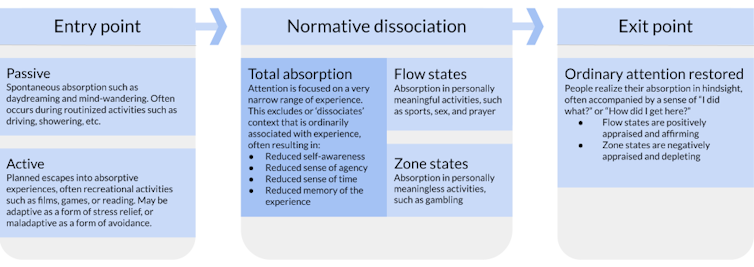
What Does Dissociation Look Like Online?
When online, however, dissociation can reflect zombie-like behaviour - scrolling for hours without realizing it, not being aware to one’s surroundings while scrolling, or scrolling on autopilot and then realizing you haven’t actually paid any attention to what you’ve read. Have you ever seen someone so absorbed in their phone that they start walking across a street, oblivious to oncoming traffic? They’re likely dissociating.
Typically, behaviour like this is classified as smartphone or internet addiction.
However, researchers have begun to push back against the narrative of addiction to describe excessive smartphone use, explaining that the behavior – even if it’s a source of distress – should not be considered addiction if it’s better explained by an underlying disorder, is a willful choice, or is part of a coping strategy.
I am of the belief that choosing to play Candy Crush for three hours a day is not necessarily “addiction.” I do, however, think that the complete disconnect people experience from their surroundings and sense of time passing is an interesting phenomenon to explore. Therefore, I wanted to understand if people are dissociating during their phone use.
In our study, we recruited volunteers to use a custom mobile app alternative to Twitter, called Chirp. Forty-three people used Chirp for four weeks, cycling through four different design interventions, coupled with in-app surveys. We then selected 11 of them to interview about the experience.
We found dissociation occurred in nearly half of our participants, and they often expressed a sense of disappointment afterwards, saying that they would have rather have engaged in a different activity with the amount of time they had spent online. However, some said their time on social media was meaningful to them, and the fact that they were connecting with real people was valuable, even as they dissociated.
Cultivating Online Agency
Understanding social media overuse as a by-product of dissociation, rather than addiction, can help destigmatize social media use while empowering users. This framing also helps explain why social media sits in a paradoxical position: people have frustrating relationships with social media platforms that they are simultaneously unwilling to quit.
Seeking escape from the present moment through deep absorption – including absorption in social media – is a natural, common, and often beneficial thing to do. However, when users spend much more time dissociating online than they would have consciously chosen for themselves, they become frustrated and conflicted. And many social media platforms exploit this tendency by keeping people “on the hunt” for new content through algorithmic design.
This suggests that it is possible for users to have healthy and satisfying relationships with social media – even when dissociating is involved – if the platforms can also help their users disengage.
How Design Can Reduce Dissociation
In our study, we deployed several interventions to help pause or reduce dissociation while scrolling on Chirp. One intervention that was particularly effective was requiring our participants to sort their content into lists by topic – say, news, sports and reality TV – rather than having all subjects appear as an avalanche of information on one main feed. People could then click different tabs to view their lists. We found that many users would only scroll through one or two tabs before exiting the app.
We paired this intervention with a “reading history” label that informed our users when they were “all caught up” with previously viewed tweets. Participants said that this helped them feel more in control and less likely to lose track of time.
Of course, many current social media companies, such as TikTok, rely on algorithmically-determined, constantly updating content. Similarly, on Instagram and Twitter, popular and trending content gets inserted into a feed of followed content. This makes it impossible to ever get “all caught up.”
In these cases, past research shows that many people would appreciate reminders to log off before 30 minutes of use. Otherwise they become disappointed with the time they’ve spent. These reminders could be inserted into regular content, which is something TikTok already does.
Users can do this for themselves by becoming familiar with the suite of digital well-being tools at their disposal. Viewing usage page statistics and setting timeouts is already available across many sites, although many of these settings are turned off by default.
However when more people use these tools, it signals to the companies that they should continue to invest time and resources into developing them.![]()
Amanda Baughan, PhD Student in Computer Science & Engineering, University of Washington
This article is republished from The Conversation under a Creative Commons license. Read the original article.
Japan’s Obon festival: how family commemoration and ancestral worship shapes daily life
Kyoko Murakami, University of BathEach year in Japan, people celebrate ohigan, a period of seven days around both the vernal and the autumnal equinoxes, and obon, which stretches over a few days on either side of August 15.
Employers grant leave to staff. Trains fill with people returning from big cities like Tokyo and Osaka to their family homes (referred to as ie) in the countryside.
These national holidays are an opportunity to rekindle relationships with both grandparents and the extended family. They are also a time when people visit their family graves.
Many Japanese people do not profess a particular faith. Yet at these specific points in the year, they visit family graves in a practice likened to ancestral worship.
While to western sensibilities, the idea of “worship” implies a religious connection, as anthropologist Jason Danely has put it, “ancestor memorial is such a common-sense and mundane practice that, for most people, it is indistinguishable from the non-religious world.”
As a social and cultural psychologist, I have researched people’s pilgrimages to graves of the war dead in Japan and in the UK. In Japan – where I originally come from – visiting the graves of family members and friends is an everyday cultural ritual and a practice of social or collective remembering.
How Obon Is Celebrated
On the first day of obon, August 13, people welcome their ancestral spirits to their homes with offerings of food and flowers at shrines or altars. They spend the next few days thanking their ancestors, eating together and deepening their bonds. On August 16, which marks the end of the festival, they have a bonfire, sending the spirits back to their world.

The altars in homes are decorated with special trays and lanterns, much like Christmas decorations in the west. For people who are culturally Buddhist, this altar will be a butsudan. For Shinto households, a kamidana.
Many traditional homes, though, have both kinds and indeed a third, a tokonoma, in which seasonal art objects (such as bonsai trees or ikebana floral arrangements) are displayed.

During obon and ohigan, people also take greater care than usual to clean their family graves, rather like spring cleaning in Britain. This act of deep cleaning is symbolic of the hope that one’s heart and mind will also be cleansed.
Once cleaning is completed, people leave offerings: flowers, sweets, or the deceased person’s favourite food. They also light incense sticks to show that they are ready to welcome the deceased. They then thank the deceased family members and ancestors and pray for peace and good health.

After cleaning, people serve ohagi and odango (sticky rice balls) and vegetarian dishes, as offerings. These change from region to region. In many places, people make so-called spirit horses (shouryouma) out of whole cucumbers and cows out of aubergines, to symbolically speed along the ancestors’ journeys to the family home.
The Importance Of Remembering Ancestors
Common to both ohigan and obon is that it is a time to be spent with, and to appreciate, your ancestors. According to Japanese law, vernal equinox day is a holiday that “celebrates nature and cares for living things”. Autumnal equinox day, meanwhile, is a holiday that “respects ancestors and mourns the dead”.
Obon is thought to have evolved out of ancient rituals, as well as the Buddhist festival of urabon-e (ullambana, in Sanskrit) and Confucianist thought. During urabon-e, family members, their relatives and close friends gather to remember the deceased and to thank their ancestors.
The festival fused the ancient Japanese ideas of respecting the ancestral spirits with the Buddhist idea of saving those who have fallen into gaki-do (“the way of hungry ghosts”) through a memorial service.
Ohigan, meanwhile, is thought to lead to the practice of rokuharamitsu, or reaching the state of enlightenment. Higan means “the other side of the river”, in contrast to the world of material desires in which we live, which is called konogishi (“this side”).
Since ancient times, animism has been a part of everyday thinking in Japan, with people viewing humans, animals and plants as living together. Research shows how in such animistic practices continue to thrive, rooted in people’s memories and experiences.

With an increasingly ageing population and changes to the nuclear family, the way in which people live and die is changing. Despite these changes, obon, like ohigan, remains an integral cultural and social practice, linking people to their family and their ancestors. What’s more, it maintains a broader connection to their spiritual roots in a fusion of different beliefs about the living and the dead.![]()
Kyoko Murakami, Honorary Research Fellow in Social Psychology, University of Bath
This article is republished from The Conversation under a Creative Commons license. Read the original article.
Procrastinating is linked to health and career problems – but there are things you can do to stop

Do you ever beat yourself up for procrastinating? You might be composing that message to a friend who you have to let down, or writing a big report for school or work, and doing your best to avoid it but deep down knowing you should just get on with it.
Unfortunately, telling yourself off won’t stop you procrastinating again. In fact, it’s one of the worst things you can do. This matters because, as my research shows, procrastination isn’t just a time-sapper but is actually linked to real problems.
Procrastination is not a result of laziness or poor time management. Scientific studies suggest procrastination is due to poor mood management.
This makes sense if we consider that people are more likely to put off starting or completing tasks that they feel aversion towards. If just thinking about the task makes you anxious or threatens your sense of self-worth, you will be more likely to put it off.
Research has found that regions of the brain linked to threat detection and emotion regulation are different in people who chronically procrastinate compared to those who don’t procrastinate frequently.
When we avoid the unpleasant task, we also avoid the negative emotions associated with it. This is rewarding and conditions us to use procrastination to repair our mood. If we engage in more enjoyable tasks instead, we get another mood boost.
Tasks that are emotionally loaded or difficult, such as studying for an exam, or preparing for public speaking are prime candidates for procrastination. People with low self-esteem are more likely to procrastinate as are those with high levels of perfectionism who worry their work will be judged harshly by others. If you don’t finish that report or complete those home repairs, then what you did can’t be evaluated.
But guilt and shame often linger when people try to distract themselves with more pleasant activities.
In the long run, procrastination isn’t an effective way of managing emotions. The mood repair you experience is temporary. Afterwards, people tend to engage in self-critical ruminations that not only increase their negative mood, but also reinforce their tendency to procrastinate.

How Is Procrastination Harmful?
So why is this such a problem? When most people think of the costs of procrastination, they think of the toll on productivity. For example, studies have shown that academic procrastination negatively impacts student performance.
But academic procrastination may affect other areas of students’ lives. In one study of over 3,000 German students over a six month period, those who reported procrastinating on their academic work were also more likely to engage in academic misconduct, such as cheating and plagiarism. But the behaviour procrastination was most closely linked with was using fraudulent excuses to get deadline extensions.
Other research shows employees on average spend almost a quarter of their workday procrastinating, and again this is linked with worse outcomes. In one US survey of over 22,000 employees, participants who said they regularly procrastinated had lower annual incomes and less job stability. For every one-point increase on a measure of chronic procrastination, salary decreased by US$15,000 (£12,450).
Procrastination also correlates with serious health and wellbeing problems. A tendency to procrastinate is linked to poor mental health, including higher levels of depression and anxiety.
Across numerous studies, I’ve found people who regularly procrastinate report a greater number of health issues, such as headaches, flu and colds, and digestive issues. They also experience higher levels of stress and poor sleep quality.
They were less likely to practice healthy behaviours, such as eating a healthy diet and regularly exercising, and use destructive coping strategies to manage their stress. In one study of over 700 people, I found people prone to procrastination had a 63% greater risk of poor heart health after accounting for other personality traits and demographics.
How To Stop Procrastinating
Learning not to procrastinate isn’t going to solve all your problems. But finding better ways to regulate your emotions could be a route to improving your mental health and wellbeing.
An important first step is to manage your environment and how you view the task. There are a number of evidence-based strategies that can help you quarantine distractions, and set up your tasks so they provoke less anxiety and feel more meaningful. For example, remind yourself why the task is important and valuable to you can increase your positive feelings towards it.
Forgiving yourself and showing yourself compassion when you procrastinate can help break the procrastination cycle. Admit you feel bad without judging yourself. Remind yourself that you’re not the first person to procrastinate, nor will you be last.
Doing this can take the edge off the negative feelings we have about ourselves when we procrastinate. This can make it easier to get back on track.![]()
Fuschia Sirois, Professor in Social & Health Psychology, Durham University
This article is republished from The Conversation under a Creative Commons license. Read the original article.
Scientists are turning data into sound to listen to the whispers of the universe (and more)

We often think of astronomy as a visual science with beautiful images of the universe. However, astronomers use a wide range of analysis tools beyond images to understand nature at a deeper level.
Data sonification is the process of converting data into sound. It has powerful applications in research, education and outreach, and also enables blind and visually impaired communities to understand plots, images and other data.
Its use as a tool in science is still in its early stages – but astronomy groups are leading the way.
In a paper published in Nature Astronomy, my colleagues and I discuss the current state of data sonification in astronomy and other fields, provide an overview of 100 sound-based projects and explore its future directions.
The Cocktail Party Effect
Imagine this scene: you’re at a crowded party that’s quite noisy. You don’t know anyone and they’re all speaking a language you can’t understand – not good. Then you hear bits of a conversation in a far corner in your language. You focus on it and head over to introduce yourself.
While you may have never experienced such a party, the thought of hearing a recognisable voice or language in a noisy room is familiar. The ability of the human ear and brain to filter out undesired sounds and retrieve desired sounds is called the “cocktail party effect”.
Similarly, science is always pushing the boundaries of what can be detected, which often requires extracting very faint signals from noisy data. In astronomy we often push to find the faintest, farthest or most fleeting of signals. Data sonification helps us to push these boundaries further.
The video below provides examples of how sonification can help researchers discern faint signals in data. It features the sonification of nine bursts from a repeating fast radio burst called FRB121102.
Fast radio bursts are millisecond bursts of radio emission that can be detected halfway across the universe. We don’t yet know what causes them. Detecting them in other wavelengths is the key to understanding their nature.
Too Much Of A Good Thing
When we explore the universe with telescopes, we find it’s full of cataclysmic explosions including the supernova deaths of stars, mergers of black holes and neutron stars that create gravitational waves, and fast radio bursts.
Here you can listen to the merger of two black holes.
And the merger of two neutron stars.
These events allow us to understand extreme physics at the highest-known energies and densities. They help us to measure the expansion rate of the universe and how much matter it contains, and to determine where and how the elements were created, among other things.
Upcoming facilities such as the Rubin Observatory and the Square Kilometre Array will detect tens of millions of these events each night. We employ computers and artificial intelligence to deal with these massive numbers of detections.
However, the majority of these events are faint bursts, and computers are only so good at finding them. A computer can pick out a faint burst if it’s given a template of the “desired” signal. But if signals depart from this expected behaviour, they become lost.
And it’s often these very events that are the most interesting and yield the biggest insight into the nature of the universe. Using data sonification to verify these signals and identify outliers can be powerful.
More Than Meets The Eye
Data sonification is useful for interpreting science because humans interpret audio information faster than visual information. Also, the ear can discern more pitch levels than the eye can discern levels of colour (and over a wider range).
Another direction we’re exploring for data sonification is multi-dimensional data analysis – which involves understanding the relationships between many different features or properties in sound.
Plotting data in ten or more dimensions simultaneously is too complex, and interpreting it is too confusing. However, the same data can be comprehended much more easily through sonification.
As it turns out, the human ear can tell the difference between the sound of a trumpet and flute immediately, even if they play the same note (frequency) at the same loudness and duration.
Why? Because each sound includes higher-order harmonics that help determine the sound quality, or timbre. The different strengths of the higher-order harmonics enable the listener to quickly identify the instrument.
Now imagine placing information – different properties of data – as different strengths of higher-order harmonics. Each object studied would have a unique tone, or belong to a class of tones, depending on its overall properties.
With a bit of training, a person could almost instantly hear and recognise all of the object’s properties, or its classification, from a single tone.
Beyond Research
Sonification also has great uses in education (Sonokids) and outreach (for example, SYSTEM Sounds and STRAUSS), and has widespread applications in areas including medicine, finance and more.
But perhaps its greatest power is to enable blind and visually impaired communities to understand images and plots to help with everyday life.

It can also enable meaningful scientific research, and do so quantitatively, as sonification research tools provide numerical values on command.
This capability can help promote STEM careers among blind and visually impaired people. And in doing so, we can tap into a massive pool of brilliant scientists and critical thinkers who may otherwise not have envisioned a path towards science.
What we need now is government and industry support in developing sonification tools further, to improve access and usability, and to help establish sonification standards.
With the growing number of tools available, and the growing need in research and the community, the future of data sonification sounds bright!![]()
Jeffrey Cooke, Professor, Centre for Astrophysics and Supercomputing, Swinburne University of Technology
This article is republished from The Conversation under a Creative Commons license. Read the original article.
Jekyll and Hyde: a tale of doubles, disguises, and our warring desires

In our Guide to the Classics series, experts explain key works of literature.
Robert Louis Stevenson’s classic novella, Strange Case of Dr. Jekyll and Mr. Hyde, was published in 1886. The Scottish author was already known for his travel writing and children’s literature – including Treasure Island – when Jekyll and Hyde appeared. However, this insightful and fantastic tale is perhaps his most unique and enduring.
As its title suggests, the story is indeed strange. It’s bound up in notions of self-estrangement, and the uncanny, which Freud describes as the familiar made strange. Inspired by a feverish nightmare, the story is about competing desires, and what might happen if we could split the good and evil parts of the self into separate identities.
The novella’s mystery plot centres on the puzzle of an unlikely connection between two opposing characters – the benevolent and respectable doctor, Jekyll, and the murderous, animalistic Hyde. The criminal Hyde uses a cheque signed by Jekyll, and Jekyll’s will is changed to make Hyde the sole beneficiary. But why? The connection, we eventually learn, is that Hyde is Jekyll. Or, more specifically, he is the embodiment of Jekyll’s evil aspects: a demonic double brought to life by a transformative potion, conjured to allow Jekyll to act out his vices in disguise. Based on his belief that “man is not truly one, but truly two”, Jekyll seeks to cordon off his dark side and let it run amok.

Written In ‘A Matter Of Days’
According to biographical accounts, Stevenson penned his tale in a matter of days. He then threw the original draft into the fire because his wife suggested the story needed work. Various reports suggest she either didn’t think the sensational story worthy of him, or felt that the allegory needed to be refined. He wrote a revised version in another few days. Stevenson said that the work “was conceived, written, rewritten, re-rewritten, and printed inside ten weeks”.
Despite its astoundingly short production, Jekyll and Hyde was an incredible success: it has never been out of print, has been reimagined in countless film and stage adaptations, and is often referenced in popular culture. In The Simpsons, for instance, Bart exhibits “some monster-ism” after drinking an experimental diet cola.
The names Jekyll and Hyde have been integrated into our everyday language. Even those unfamiliar with the book (and its many adaptations and riffs) know that “Jekyll-Hyde” means twinned good and evil, or the split personality. According to Urban Dictionary, “Jekyll-Hyde” is a colloquialism for someone whose erratic behaviour makes them seem like two different people.
Sensationalism And Radical Science
Sensationalism was a popular genre that emerged in Britain in the 1860s. These sensational novels – often called railway novels, because cheap editions were sold at stations to be read on long train journeys – typically took place in recognisable, contemporary settings, with plots often revolving around shocking crimes, doubles, and mistaken identities. Jekyll and Hyde adheres to many conventions of the genre. Set in 19th-century London (in real-life locations such as Cavendish Square, Soho, and Regents Park), it represents violence, murder, and mirrored, fluid protagonists.

The text is also distinctly gothic in its engagement with supernatural themes such as metamorphosis, and its delving into the dark side of human psychology and desire. There are some interesting crossovers between Jekyll and Hyde and Mary Shelley’s seminal horror story, Frankenstein (1818). In both cases, a radical scientist brings a monstrous, violent creature to life, and is then horrified and plagued by his own creation.
While Hyde is not as complex as Frankenstein’s monster – a character driven mad by isolation and the prejudice of others, but capable of love and empathy – both texts force us to question whether the monsters are really to blame for their crimes, or whether we should be pointing the finger at their irresponsible creators? More broadly, they force us to question whether society’s monsters (murderers and other villains) are born “evil”, or if their antisocial behaviour is created by outside forces.
Stevenson had been friends with a doctor, Eugene Cantrelle, who was later convicted (in 1878) of murdering his wife for a life insurance payout. Stevenson, who was present throughout the trial, was reportedly traumatised by discovering the dark side of his seemingly normal friend (who was also believed to have committed other murders). This may have influenced Stevenson’s novella, which was published eight years later.
Blending elements of sensation and gothic fiction, while also imparting moral lessons and reflecting on the intricacies of human nature, the story is both thrilling and thought-provoking. In a contemporary review, novelist Henry James refers to the tensions between moralism and excitement in the text, asking, “Is ‘Dr. Jekyll and Mr. Hyde’ a work of high philosophic intention, or simply the most ingenious and irresponsible of fictions?”.
Careful examination tells us that it is, in fact, both – a mesmerising horror story and a stylistically complex work that meditates on social issues as diverse as moral philosophy, the dangers of drug use, and the repressive codes of Victorian society, to name a few.
The Moral Of Man’s Doubleness
Stevenson explains he based the story on “that strong sense of man’s double being which must at times come in upon and overwhelm the mind of every thinking creature”. Although the book is only ten chapters long, it engages with complex questions about moral conflict, or the internal battle between our carnal – not always honourable – desires and our ethical responsibilities.
It also taps into contemporary concerns about the ethics of scientific and medical advancements. Jekyll is a pioneer of “transcendental medicine”; his experimental cocktail allows him to take on an unrecognisable form and commit atrocities without sacrificing his own good name. This raises a question that still resonates today: what is at stake when technology and power are used for personal gain?

Jekyll’s first transformation is intoxicating and liberating:
I knew myself, at the first breath of this new life, to be more wicked, tenfold more wicked, sold a slave to my original evil; and the thought, in that moment, braced and delighted me like wine.
This “new life” lived through Hyde, who nonchalantly knocks down a small child in the street and frenziedly bludgeons a kindly old man to death, becomes a secondary outlet through which Jekyll’s base cravings can be channelled. Yet, expressive freedom turns to stifling bondage when Jekyll’s mutations into his evil twin become involuntary, and progressively more difficult to reverse.
Having flexed and strengthened his dark side, it takes him in a chokehold and refuses to let go. Hyde cannot be suppressed or flung aside, because he is an integral part of the whole self. Unlike Frankenstein’s monster, which is independent of its maker, Jekyll’s creation is an essential, inseparable part of himself – a different dimension of the same identity.
The Mythical And The Beastly
The narrative moves between past and present, building suspense by setting up the mystery of Hyde’s identity before finally taking readers into its confidence. Its fictional world is drawn through various perspectives, including two first-person accounts. No matter whose eyes the world is filtered through, it is a place of confusion and uncertainty, where characters try to figure each other (and themselves) out.

We are rarely aligned with Hyde’s gaze. He remains an inaccessible, somewhat distant figure – more of a boorish caricature than a complex human. Characters who encounter Hyde form only a distorted, vague sense of him – thus hinting that he is a spectral, intangible figure. One recalls, “He must be deformed somewhere; he gives a strong feeling of deformity, although I couldn’t specify the point”.
It’s as if we can’t get Hyde in full view, or see him in a broad light, seeming to signal a lack of substance. As a figure of “pure evil”, with any semblance of good cellared in his other self, Hyde emerges as an incomplete half-creature. To take an idiom that typically relates to mental incapacity, the extremely diabolical Hyde is (morally) “not all there”.
Physically furry and energised by primal impulses, he’s represented as more animal than human. His hands are covered in “swart” hair; he bares and gnashes his teeth when enraged, and physically treads over his victims like a stampeding beast.
Hyde’s vicious, almost feral side is most pronounced in the scene where he beats an old man who stops him in the street and politely asks for directions:
Mr. Hyde broke out of all bounds and clubbed him to the earth. And, next moment, with ape-like fury, he was trampling his victim under foot, and hailing down a storm of blows, under which the bones were audibly shattered and the body jumped upon the roadway.
Adaptations: Prosthetics, Parody, And An Oscar
With its thrilling plot and universal themes, Jekyll and Hyde lends itself to dramatic adaptations and reimaginings. There have been countless film versions; there’s even an IMDB list of the best and worst.

Adaptations range from horror-comedies to psychological dramas. In the 1931 film, Dr Jekyll and Mr Hyde, for which Fredric March won the Academy Award for Best Actor, the animal dimensions of Hyde are borne out visually. March dons a set of false teeth resembling canine fangs and a wig of shaggy hair that sits so low on his forehead, it almost meets his eyebrows.
In his 1990 portrayal of the title character, in Jekyll and Hyde, Michael Caine plays up the bodily grotesqueness of the character, making him more ogre than human. It’s a departure from Stevenson’s notion that Hyde’s deformity is sensed, but not quite visible.
The 1996 film, Mary Reilly, offers a subtler rendition of Stevenson’s story, and also introduces a new character – Jekyll/Hyde’s housemaid, Mary (played by Julia Roberts), who sees and loves both men. (Notably, there are no central female characters in the book.) John Malkovich takes on the paired roles of Jekyll and Hyde, infusing both with a charismatic intensity.
In this retelling, there are no prosthetics or special effects to distinguish the villain, and Hyde is recognisable only by his long, black hair and clean-shaven face, in contrast to the grey, goateed Jekyll. Although the film retains the gory violence of the original text – at one point, the villain is shown holding the severed head of a brothel madam – it gives Hyde a psychological depth, and a capacity for romantic attachment, which Stevenson does not afford him.
In a parodic sketch for Saturday Night Live in 2009, Bill Hader plays the part of Dr Jekyll, with Hyde as a made-up alter-ego through which he acts out his homosexual urges. He tells a group of colleagues, “I’m attracted to women, like my wife. It’s Mr Hyde who does stuff with guys.” This comical reworking mocks the absurdity of the transformative potion, a plotline that also drew complaints from many contemporary critics. But it stays true to the themes of split desires and their expression through a second, secret self.
A Human Problem
Despite its fanciful premise of the distillation of evil through shape-shifting, the anchoring concerns of Jekyll and Hyde are profoundly and universally human. This classic text forces us to confront uncomfortable questions about morality and responsibility: do the best of us have a bad side that is suppressed, waiting to get out? How would we act if we had a duplicate identity that couldn’t be traced back to us – an invisibility cloak, of sorts?
Stevenson’s fever-nightmare comes to life in this vivid, haunting tale, immersing readers in a dystopian world where sympathy and self-control give way to reckless self-indulgence. It is a world from which we must all recoil.
Strange Case of Dr Jekyll and Mr Hyde is on at the Roslyn Packer Theatre until September 3.![]()
Stephanie Last, PhD candidate, University of Sydney
This article is republished from The Conversation under a Creative Commons license. Read the original article.
The Return Of Joni Mitchell


Men's Sheds Grants And Movember Improving Men's Health
Record Numbers Access Government Home Equity Scheme
Lying down, sitting, leaning over? What science says about the best way to take your medicine

When pharmacists dispense tablets or capsules they commonly advise when and how often to take them, and if this needs to be with or without food.
You generally don’t hear them tell you to lean to one side when swallowing. But preliminary research from Johns Hopkins University in the United States suggests this might improve how fast your medicine is absorbed and gets to work.
The results are based on a computer simulation, rather than in actual patients, and may not equate to the real world. So it’s too early to suggest you strike a yoga pose when taking your medicine.
But your posture can be important when taking pills or capsules, for comfort or safety.
What Happens When You Swallow Your Medicine?
Once you swallow a tablet or capsule, it moves down the throat to the stomach. There, a tablet swells and disintegrates, or a capsule breaks open. The drug can then dissolve and your body can absorb it.
Most drugs do not start being absorbed until they reach the small intestine. However, some drugs, such as aspirin, are likely to be absorbed in the stomach because of its acidic environment.
A number of other factors can also affect where and how a drug is absorbed.
These include how fast the tablet disintegrates to release the drug, how fast the swallowed contents move from the stomach to the small intestine, the amount of food and drink consumed before taking the medicine, and how easily the drug is absorbed across the gut lining.
How About This Latest Study?
The US researchers used computer simulations to investigate how posture affects how drugs are absorbed.
The researchers used software they developed to simulate several ways of taking a pill: staying upright, leaning to the left or right, or leaning backwards.
They showed leaning 45 degrees to the right favoured a faster movement of stomach contents into the duodenum (the first part of the small intestine). This would allow the pill to be absorbed more quickly and start to take effect.
The results could be important for medicines that you’d want to act quickly, such as pain medicines, or ones used to treat a heart attack.
There is already some earlier evidence from real patients suggesting posture may influence how medicines are absorbed. This includes the option of leaning to the right. But the authors acknowledge many factors influence absorption, not just posture.
When Is It Best To Sit Or Stand?
Sometimes your pharmacist may advise you to swallow your medicine sitting, standing, or lying down for reasons other than speeding up absorption.
For example, certain drugs are more likely to cause side effects such as heartburn, where stomach acid leaks from the stomach and moves up into the oesophagus (food pipe).
These include non-steroidal anti-inflammatory drugs, such as ibuprofen (Nurofen), diclofenac (Voltaren), and iron supplements.
So if this is a problem for you, it may help to take these medicines sitting or standing, and not lying down straight away afterwards. That’s because your stomach acid is less likely to leak back up into your oesophagus.

Some medicines can irritate the throat if they become stuck. This is because they damage the protective mucosal barrier that lines your oesophagus and stomach, causing irritation and inflammation.
For these medicines it is important to take these sitting up or standing, and remaining upright for 30 minutes afterwards.
These include the antibiotic doxycycline, and drugs known as bisphosphonates (for osteoporosis), such as risedronate (Actonel) and alendronate (Fosamax).
How About Lying Down?
Glyceryl trinitrate (Nitrolingual) is an under-the-tongue spray. It’s prescribed to people with angina, a type of chest pain caused by an underlying heart problem.
Pharmacists advise patients to sit or lie down before using this spray as it can cause a sudden drop in blood pressure, making you feel very dizzy.
Other heart medicines, such as diuretics, are also known to cause dizziness. Although you don’t usually need to take these medications lying down, if you do become dizzy it is best to sit or lie down, and ensure you stand up slowly afterwards.
There are also medications that can cause drowsiness or make you feel “woozy”. These can include strong pain killers (such as opiates), sleeping tablets, some epilepsy medications, or drugs for certain mental health conditions, such as anxiety or schizophrenia.
These don’t need to be swallowed while lying down, but lying down can help if you become dizzy or drowsy.

What If I’m Not Sure?
Next time your pharmacist dispenses your medicine, unless they provide specific guidance about sitting, standing or lying down, you are generally safe to take it whichever way is most comfortable.
So how about this latest evidence suggesting leaning to the right might help? At this stage, you likely won’t hear your doctor or pharmacist recommend you should lean over to take your medicines until further research is done.
But next time you need to take a medicine for pain, as long as it is not uncomfortable, feel free to try this to see if your pain is relieved faster.![]()
Elise Schubert, Pharmacist and PhD Candidate, University of Sydney; Nial Wheate, Associate Professor of the Sydney Pharmacy School, University of Sydney, and Tina Hinton, Associate Professor of Pharmacology, University of Sydney
This article is republished from The Conversation under a Creative Commons license. Read the original article.
Aged Care Roundtable Advances Practical Solutions
Feeling Frail? Here’s How To Beat It
- Shrinking: You’ve unintentionally lost 10 or more pounds in the past year.
- Feeling weak: You have trouble standing without assistance or have reduced grip strength.
- Feeling exhausted: Everything you do takes a big effort, or you just can’t get going for three or more days most weeks.
- Activity level is low: This includes formal exercise plus household chores and activities you do for fun.
- Slow walking: Your pace is considered slow if the time it takes you more than six or seven seconds to walk 15 feet.
- A history of falls: If you have fallen more than once in the past six months, you are more likely to fall again.
- Low blood pressure: Older people with naturally low blood pressure may feel light-headed, dizzy or unsteady while moving.
- Postural (orthostatic) hypotension: With this condition, blood pressure drops when changing positions, such as sitting to standing. Older people with postural hypotension, whether natural or due to a medication’s side effect, are at increased risk of having a fall.
- Incontinence: You may need to hurry to the toilet often, increasing the risk of a fall, particularly at night.
- Stroke, Parkinson’s disease and arthritis: These conditions change how you move. They make it harder to react quickly and stop yourself if you stumble.
- Diabetes: Changes in blood sugar levels can make you feel faint. Diabetes can also affect your eyesight and reduce the feeling in your feet and legs.
- Depression: Older people with depression may take a medicine that can increase their risk of falling.
- Alzheimer’s disease and other dementias: Older people with dementia can become less aware of their surroundings and less able to react quickly.
- Sydney - Padstow, Chatswood, Bexley, Hurstville.
- Melbourne - Epping, Mulgrave, Keilor East.
- Canberra - Monash, Florey, Rivett.
- Brisbane - Eagleby, Raceview, Birkdale.
- Adelaide - Hallett Cove, Happy Valley, Mount Barker, Golden Grove.
- Perth - Armadale, Canning Vale, Bassendean, Kingsley.
- Darwin - Fannie Bay, Rapid Creek, Wanguri.
- Hobart - Risdon Vale, Brighton, South Hobart.
Seniors Left Out In The Cold – Here’s How To Help
- Older people aged 50 years or older and are prematurely ageing.
- Aboriginal and Torres Strait Islander people aged 45 years and older.
- Those on a low income.
- Halve the number of households experiencing rental stress by 2027 and end rental stress by 2032;
- End homelessness for women, children and young people;
- End homelessness for Aboriginal and Torres Strait Islander Australians;
- Halve the numbers of people returning to homeless services by 2027, and halve the numbers again by 2032.
- Building 25,000 social housing properties a year.
- Providing a housing guarantee to women and children fleeing family violence.
- Providing homes and support to people who have been homeless multiple times to help them stay housed.
- Providing young people who can’t live at home with the support they need to succeed.
- Increasing JobSeeker to at least $70 a day and boosting Commonwealth Rental Assistance by 50 per cent.
Dementia Action Week
19 – 25 September 2022
- Give a little support to a person living with dementia.
- Give a little support to a carer, friend or family member of a person living with dementia.
- Help healthcare professionals make their practice more dementia-friendly.
‘We’ve all done the right things’: in Under Cover, older women tell their stories of becoming homeless
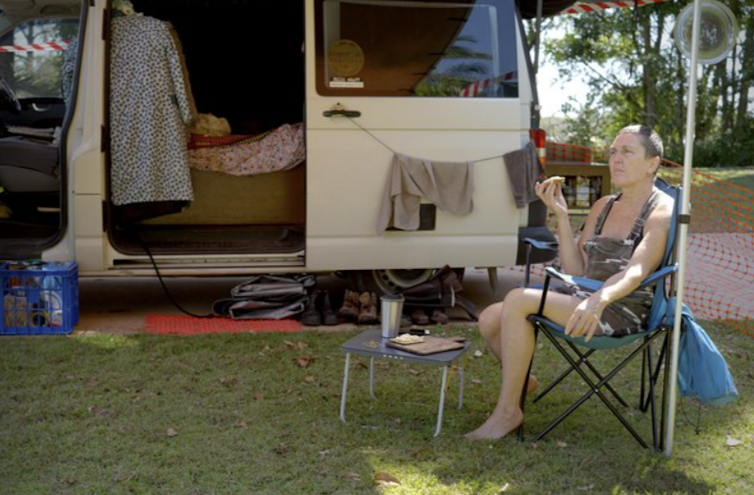
The Australian documentary Under Cover, premiering at the Melbourne International Film Festival, presents the voices and faces of older women’s housing insecurity. Many of us would have seen the figures: the number of homeless people aged 55 years or above increased 28% between 2011 and 2016. And single women of that age are the fastest-growing homeless group in Australia.
But knowing the statistics is different from witnessing the reality. In Under Cover, filmmaker Sue Thomson depicts the stories of ten older women who have experienced housing insecurity and homelessness. They live in hostels, community housing, their cars, vans, caravan parks.
All have travelled different routes, but leading to each individual experience is a chain of similar factors: taking time off work to care for children, having little or no superannuation, experiencing relationship breakdown that leaves them without money or assets, eviction. For some, additional factors include family violence and the enduring impacts of colonisation.
These women filled the role in society that women are expected to, caring for husbands, elderly parents and children. As one of them points out:
We’ve all done the right things, you know. We got married, we stayed at home, we’ve raised our children.
They feel shock, grief and frustration that, in return for their service, they have ended up here, beyond the edge of poverty. For many, the routine acts of waking and washing, food preparation, seeking an income, maintaining precious belongings, sleeping and staying safe take place in spaces of transience and mobility.
Many of the women say they never thought they would end up homeless; it was something that happened to other people. They are articulate, reflective, everyday women who were blindsided. As one of them says:
I had never ever considered that I would be homeless. Never.
Indeed, in advocating for political change, the film powerfully presents the idea that homelessness can happen to anyone.
Risks Are Rising With Rental And Living Costs
The pressures that lead to people becoming homeless are increasing. Rental and living costs are soaring.
Anglicare’s Rental Affordability Snapshot shows rents are more unaffordable than ever before, especially for people on low incomes. Nationally, only 0.7% of listed private rental homes were affordable for a single adult on the aged pension. Only 1.4% were affordable for couples on the aged pension.
An Australian property market geared to make profits, rather than provide housing as a basic human right, is having stark long-term impacts. When the next Census homelessness estimates are released in 2023, it’s likely we will see more older women are at risk of homelessness – and more Australians across all age groups and genders with first-hand experience of not having a home.
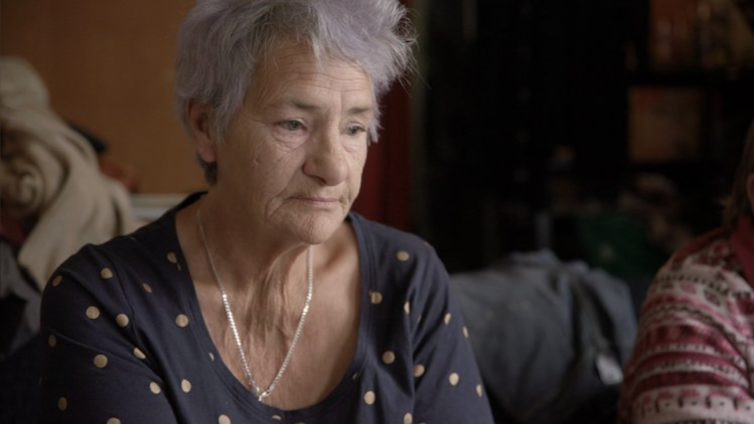
Solutions Must Include More Affordable Housing
The film highlights some important programs and organisations that are helping homeless women. But, as Margot Robbie’s narration makes clear, non-government organisations cannot do the work without government support.
Currently available social or affordable housing may be located far from women’s social networks and community. They may be given a stable home but at the cost of their sense of belonging.
Significantly more social and affordable housing is needed. This will ensure people have suitable options and don’t have to move long distances to receive shelter. Temporary housing is also necessary but insufficient.
Recent research also assesses innovative housing models for older people. Suggested solutions include co-operative living and shared-equity schemes. These are consistent with the reported aspirations of older Australians who require safe, secure housing to age well. Options include downsizing or “rightsizing” in later life.
Having stable, alternative housing available will help older people who cannot stay in the family home, whether because their relationship breaks down or they never owned property.
More broadly, Australian housing policy needs to understand housing as a human right that is fundamental to people’s wellbeing. Housing should be safeguarded as essential social infrastructure.
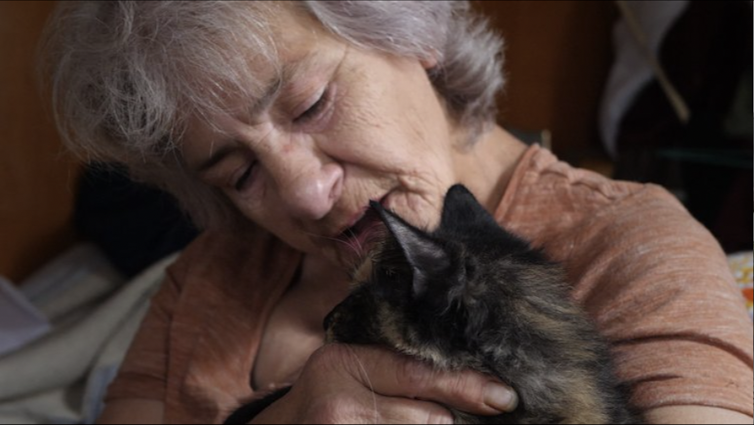
Broader Social Policy Changes Are Essential Too
Other measures to prevent older women from becoming homeless will require policy beyond housing: better parental leave schemes, pay equality, domestic violence responses, closing the superannuation gender gap. In short, it depends on overcoming gender inequality on all levels and scales. These are big tasks, but they must be undertaken for a fair and just society.
Under Cover makes it clear we cannot continue the way we are, or these problems will continue through to the next generations. Today’s young women will be tomorrow’s older homeless women, wondering how on Earth they ended up here. As one woman in the film says:
I couldn’t believe this was me. I couldn’t believe after all these years that I would be in this situation.
The need for both gender-focused and age-focused housing solutions is urgent.
People experiencing homelessness are often regarded as invisible, as are older women. Homeless older women may be doubly invisible. But by getting into the specifics of their homelessness, Under Cover brings their experiences into the light.
You can’t make policy about something you can’t (or don’t want to) see. With the federal government’s commitment to national co-ordinated housing policy, and Prime Minister Anthony Albanese’s open discussion of being raised by a single mother in public housing, perhaps there is a fairer Australian housing landscape on the horizon.
A sequel to Under Cover that focuses on “how older women’s housing insecurity and homelessness was solved” would be welcome. In the meantime, government action, supported by research that increases understanding of age, gender and other intertwined vulnerabilities, is badly needed. Also critical are the conversations at kitchen tables, in local neighbourhoods, in workplaces, among friends and in news media that Under Cover will provoke.
Under Cover is screening at the Melbourne International Film Festival until August 20 and is streaming at MIFF Play until August 28.![]()
Zoe Goodall, Research Associate, Centre for Urban Transitions, Swinburne University of Technology; Margaret Reynolds, Research Fellow, Centre for Urban Transitions, Swinburne University of Technology; Piret Veeroja, Research Fellow, Centre for Urban Transitions, Swinburne University of Technology, and Wendy Stone, Professor of Housing & Social Policy, Centre for Urban Transitions, Swinburne University of Technology
This article is republished from The Conversation under a Creative Commons license. Read the original article.
Vitamin D Supplementation Seems To Alleviate Depressive Symptoms In Adults
Prehistoric Podiatry: How Dinos Carried Their Enormous Weight
How to help your child write a speech (without doing it for them)

It’s hard for parents to help kids with homework without doing it for them. It can be especially difficult to work out where to start when your child is preparing a speech for school.
You might find your child is procrastinating more about getting started with a speech than about other homework. This could be because they are anxious about it.
Having something that they want to say to their class can help to increase your child’s confidence and motivation when they deliver the speech. A positive speechmaking experience can increase confidence for next time, which is why some schools teach public speaking in a systematic way.
It’s important to keep in mind that public speaking has two parts to it: writing the speech, and delivering it.
Here are some tips for how to help your kid with both aspects of preparation.

Writing The Speech
First, help your child find something they want to say to their audience.
When a child is delivering a speech to the class, they are being listened to, observed, and watched by their peers. Most other classwork is only read by the teacher. In a speech, they are sharing their ideas with the whole class.
That’s why it is really important they own what they are saying, and say it in their own words.
It’s key they own the topic (if it is a free choice of topic) or that they own the stance they are taking (if the topic is set by the teacher).
As a parent, it’s tricky to support your child to find their own words to say – but it’s very important you don’t write the speech for them.
Help them to think about what they care about and what they think is important to share with their class.
Apart from the fact the teacher will spot a parent-written speech a mile away, if your child has no ownership of their speech, they will not care about communicating the ideas to the class.
Next, help your child to think about organising their ideas.
It’s good to have a hook or a catchy introduction into the main idea of the speech. That could be a rhetorical question, an anecdote or an amazing fact. They can then think of around three main points about the topic.
Ask your child questions that help them to think about some examples or evidence that support their ideas.
Finally, help them to finish their speech. Often, the ending might return to the beginning to round off the point being made – a kind of “I told you so”!

Delivering The Speech – 4 Tips For Parents
1. Encourage your child to focus on communicating their idea to their audience.
If they focus on sharing their ideas, rather than worrying about themselves, everything will come together. Encourage them to think about looking at the audience and making sure everyone can hear them.
2. Practise the speed of delivery and time their speech.
One of the easiest things to practise that makes a big difference to the delivery of the speech is the pacing.
The big tip is to slow down. When speakers feel nervous they tend to speed up, sometimes just a little — but often students will deliver their speeches at breakneck speed, racing to just get it done so they can go and sit down.
I’ve listened to thousands of student speeches and have never heard one delivered too slowly. But I have heard many that sound like a horse-race call.
3. Be an affirmative audience to their speech.
Listen to your child practise when they feel ready to share with you, but don’t push them if they are resistant.
Focus on building their confidence by talking to them about the moments you felt they were connecting with you as an audience member. Be appreciative of their jokes or show you share their feelings about ideas they care about.
Your children seek your approval – don’t be stingy with it.
4. If they are feeling confident, suggest they work on nuancing their delivery.
Once they are feeling confident about delivering the speech, the child can add variety and texture.
For instance, they might slow down for emphasis on certain words, add a pause after asking a question, or think about some moments where they might speak more softly or loudly.
Variation will add interest to the delivery of the speech and help to grab and keep the audience’s attention. It also helps further convey your child’s ideas.

Good Support Takes Time
It’s hard to get the balance right when supporting your child to prepare their speech. The trick is to understand that it will take more than one sitting.
So, plan for a few chunks of time, and work on building their ideas and enthusiasm.![]()
Joanne O'Mara, Associate Professor in Education, Deakin University
This article is republished from The Conversation under a Creative Commons license. Read the original article.
Not All In The Genes: Are We Inheriting More Than We Think?
Curtin Enabling Better Lives Through Consumer-First Health Research
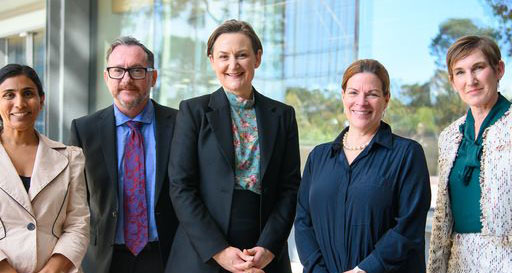
- Child and Family Health – Research endeavours to improve the physical and mental health of children and their families for a promising future. It focuses on the first 1000 days of life and how to pave a way for a healthy and happy future;
- Mental Health – Research will help identify the mental health priorities in WA and ensure everyone has a voice in that process, with a mission to help care providers understand how to keep people well and flourishing.
- Optimising Health & Wellbeing – Multidisciplinary and collaborative research to optimise health and wellbeing recognising that these are influenced by the physical, environmental, emotional and social experiences of our unique lives.
- Dementia and Ageing – Working with community, people living with dementia and those providing care to help them live their best lives. This research will help answer questions that the most affected by dementia and ageing feel are important.
Workers Left Behind By Australia’s Changing Retail Sector
A Digital Tool Is Helping Cancer Survivors Cope With Fear Of Recurrence
Multiple Shots Of The BCG Vaccine Protect Type 1 Diabetics From COVID-19, Study Finds
Exercise Answer: Research Shows It's How Often You Do It, Not How Much
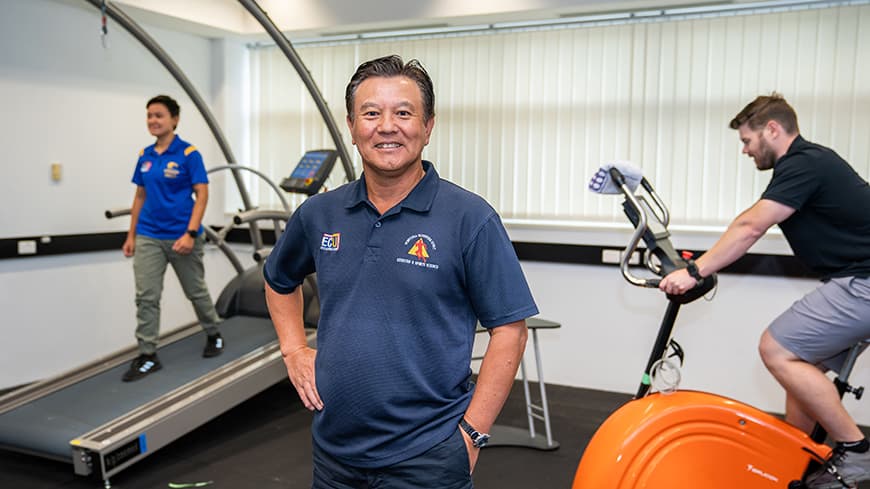
Explainer: Scott Morrison was sworn in to several portfolios other than prime minister during the pandemic. How can this be done?

It has been reported that, during the pandemic, the then prime minister, Scott Morrison, swore himself in as a minister to several portfolios, including health, finance and resources.
Can this be done?
Uncertainty About The Facts
First, there are inconsistent stories about what occurred. There has been reference to Morrison “swearing himself in” as a minister, when only the governor-general can appoint ministers.
It has also been said the attorney-general found a way for the governor-general to be cut out of the process by making changes by way of an administrative order. It is claimed the health minister knew about and supported such action, while the finance minister and the resources minister were unaware.
Another news story said the Commonwealth government has presented evidence to court that the prime minister was sworn in as minister for resources by the governor-general on April 15 2021.
It has since been confirmed the governor-general did appoint the prime minister to administer other ministerial portfolios, but no details have so far been provided. The details of exactly what happened therefore remain unclear.
Can Ministers Share The Administration Of Legislation?
Because the titles and roles of ministers change all the time, statutes tend simply to confer power on “the minister”, without specifying which one. Section 19 of the Acts Interpretation Act says that to work this out you should look to the relevant “Administrative Arrangements Order”.
An Administrative Arrangements Order sets out the matters and legislation that fall within the responsibility of particular departments and their administering minister.
For example, during the pandemic, the Administrative Arrangements Orders said the Biosecurity Act was administered by the minister for health in relation to human health and the minister for agriculture in relation to animals and plants. They did not allocate the administration of this act to the prime minister.
The governor-general makes Administrative Arrangements Orders on the advice of the Federal Executive Council. The orders are published on the Federal Register of Legislation. No such order allocates the administration of the health, finance or resources legislation to the prime minister.
So the only way the prime minister could exercise powers granted by that legislation was if he was also appointed, or acting, as the minister for health, finance or resources.
The Cabinet could reach a collective decision about a policy issue, including how a minister’s power should be exercised in relation to it, and the minister would be bound by collective ministerial responsibility to act consistently with that decision. But the prime minister alone has no legal power to instruct a minister how to exercise powers conferred by statute on that minister.
Can A Minister Exercise The Powers Of Another Minister?
Ministers can be struck down sick, go on holidays or be out of the country on business, so there is always a need for another minister to be able to exercise their powers. This is recognised in section 19(4) of the Acts Interpretation Act, which says a reference to a minister in an Act can include a reference to another minister who is acting on behalf of the first minister.
But this is usually when the first minister is unavailable. It is therefore different from the scenario of the prime minister simultaneously having the same powers as the ministers for health, finance and resources.
Section 34AAB of the Acts Interpretation Act also says that a minister who administers an Act may authorise another minister to act on behalf of the first minister in exercising powers under the Act. The authorisation must be in writing.
It is possible this power was used if, for example, the health minister agreed to exercise it. But it would not cover cases where the first minister did not choose to grant such an authorisation and did not know about it.

Appointing A Minister To Administer A Portfolio
It is the governor-general who appoints ministers to particular portfolios and swears them in. This happens under section 64 of the Constitution. It is ordinarily done publicly, when a new ministry is being sworn in. The ministerial changes are then published in the Commonwealth Gazette and on the Federal Register of Legislation.
For example, on February 6 2020, Keith Pitt was appointed as minister for resources, water and Northern Australia. But it does not seem any ministerial change announcement was made for the appointment of the prime minister to become minister for resources in April 2021 (or at least, I haven’t yet found it).
A spokesperson for the official secretary of the governor-general stated:
The Governor-General […] appointed former Prime Minister Morrison to administer portfolios other than the Department of the Prime Minister and Cabinet.
This was done by an administrative instrument on the advice of the prime minister. The spokesperson also stated the decision whether to publicise such appointment is a matter for the government of the day.
Secrecy And Transparency
Is it appropriate for ministers to be secretly appointed to exercise statutory powers?
No, such matters should be notified to parliament and formally published so members of the public can know who is entitled to exercise particular powers. That is why we have Administrative Arrangements Orders and notifications of changes in ministerial responsibility that are recorded on the Federal Register of Legislation.
It is inappropriate for such matters to be kept secret – especially if it is kept secret from the Cabinet and from the minister who was formally allocated responsibility for a portfolio by the governor-general.
Such a lack of transparency is indicative of a lack of respect for the institutions of government and for the general public who have a right to know how power is allocated.![]()
Anne Twomey, Professor of Constitutional Law, University of Sydney
This article is republished from The Conversation under a Creative Commons license. Read the original article.
Disclaimer: These articles are not intended to provide medical advice, diagnosis or treatment. Views expressed here do not necessarily reflect those of Pittwater Online News or its staff.
